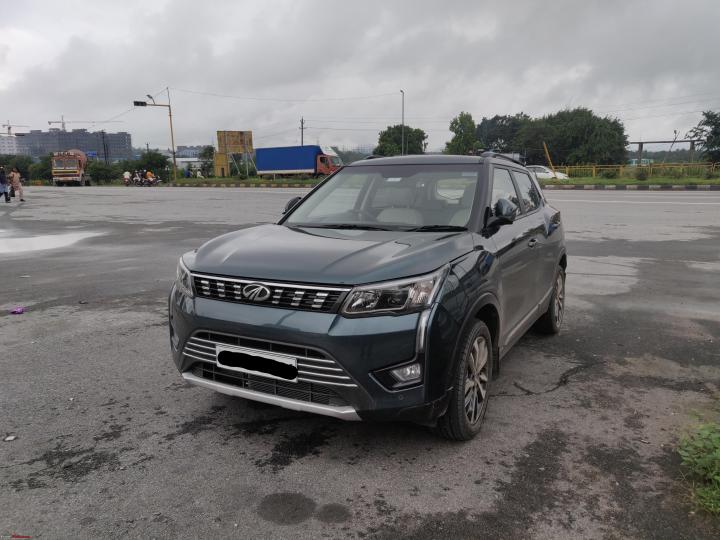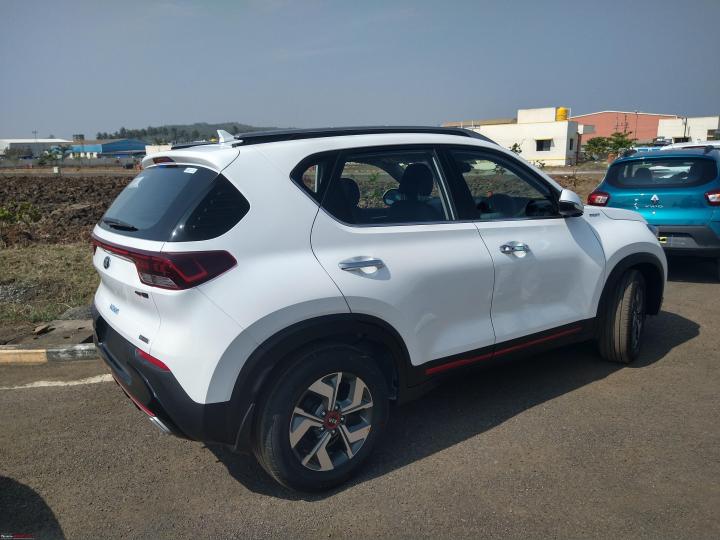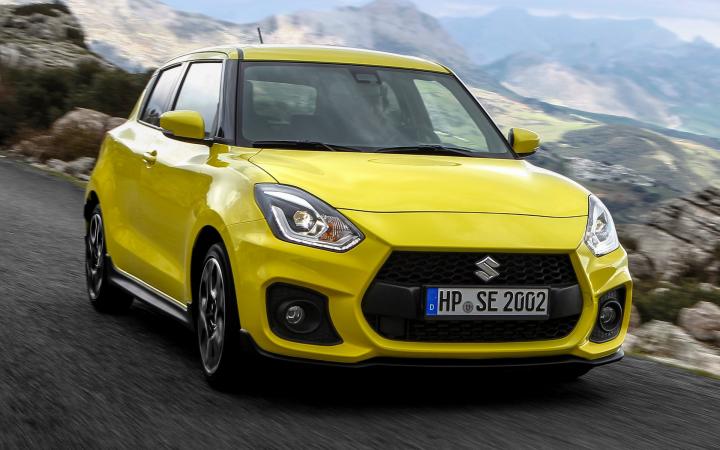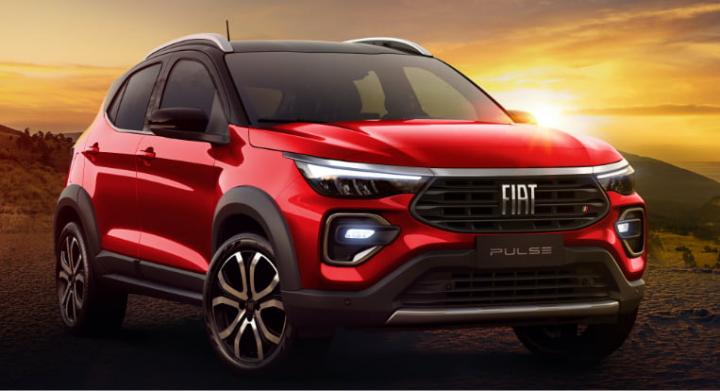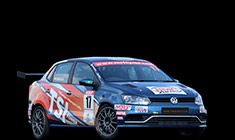News
Facing errors while connecting the OBDII scanner to my XUV300
While I knew that the scanner itself doesn't damage any hardware, it clearly can screw up the sensors to an extent that they stop working.
BHPian krishnakumar recently shared this with other enthusiasts.
Hi BHPians,
I recently purchased an OBDII scanner with plans to do some interesting analysis with my XUV300.
I had bought this just in time for a 2 weeks long 1600km road-trip. However, the very first time I connected the scanner itself, the car's MID started throwing multiple errors - particularly ESC and TPMS warnings. I disconnected the scanner and things went back to normal. Slightly dejected, we set out on our trip as I had no other option.
The real big mistake!
In between our trip, while in Gokarna, I had this "genius" idea to try and reconnect the scanner again and check. So I did and this time, even more errors came up on the system including parking sensor failures (engaging reverse gear will show nothing on the screen).
Scared, I disconnected the OBDII scanner but to my surprise the errors did not go away this time. I restarted the car multiple times and nope, the errors still continued. Even more scared, I thought I'll lock the car and leave it untouched for a while but to my shock, the request sensors also apparently failed. Which meant my key (remote) stopped working. I'd have to manually lock the car. Also, I couldn't open the boot (since there is only the request sensor to open it).
I was sweating profusely by now and was cursing myself to have tried these shenanigans in a remote location. I had the contact of a technical manager from Sireesh Marathahalli, whom I called, and he suggested to remove the battery terminals. I managed to access the tools from the rear seats and disconnected the battery. Waited for 5 mins and reconnected. Thankfully, things got reset and everything was back to working order.
While I knew that the scanner itself doesn't damage any hardware, it clearly can screw up the sensors to an extent that they stop working. This is certainly scary, especially not knowing to what extent they can affect.
I know that BHPian Vijin has done some excellent analysis with an OBDII scanner on his XUV300. So it is possible in an XUV300.
I'd love to do some analysis and I can't stop the itch of buying one again to connect and give it another try. However, the scare that happened earlier is keeping from trying to be bold again. I don't want to end up voiding warranty.
Can experienced BHPians, especially with OBDII scanners, throw some light into this? Is there a compatibility issue? Is it just a problem with the device I bought?
Here's what BHPian Kosfactor had to say on the matter:
Incompatible scan tools can disrupt comms between different modules in the vehicle. If you had kept it plugged in, it would have eventually drained the battery as well.
Throw it away, spend money on fuel and explore the country. Whatever you need to know about the vehicle is provided in the IP & MID.
Here's what BHPian Chhanda Das had to say on the matter:
Oh no, this is very unfortunate. I have the exact same product from the exact same seller which I have been using without any issues since 2017 in my first-generation petrol 1.6 Creta AT.
From my limited knowledge/experience, I can think of only a few possibilities as to why the product didn't work as intended. Here they are with their possible solutions:
- There are multiple versions/iterations of the OBD2 standards like OBD2A, OBD2B, etc. Hence, it would be best to verify the standard in your car by consulting Mahindra personnel first and then check with the seller to verify if the product supports that standard in your car. You can find more information (unverified) about the different pins and the standards of the OBD2 port in the following link.
- The product itself may be defective. The obvious solution is to replace/return it. If I remember correctly, Amazon India usually has a 10 day return policy.
- There is a very slim chance that Mahindra could have used a non-standard/uncommon wiring setup since these OBD2 adapters are usually designed to be mostly universal in nature. The few exceptions that are not supported are usually mentioned on the seller/manufacturer's website. From what I had seen till 2017, most Mahindra cars and some Toyota cars had compatibility issues with these OBD2 adapters. The one that I have (same as yours) didn't even fit on my neighbour's old Innova despite the car having an OBD2 port. In case your car is not supported, sadly there is not much that you can do.
If you want to experiment with these things in your car then it is best to do so on your home turf and that too within the early portions of the warranty period so that you may have enough leeway for things to go bad (if they do so) and to claim warranty (if necessary) if you catch my drift.
I do not know what else to say. I hope this helps. Wishing you the best.
Here's what BHPian vgaquarius had to say on the matter:
Hi! This seems to be a really unfortunate incident which happened with You. All diagnostic connectors make use of the same 16 pin OBD connector with a designated pinout but CAN protocols can differ from one car manufacturer to other. Different BCMs/ECMs work on different signalling protocols and that's why we have specific diagnostic circuitry and softwares which vary from company to company. There are many universal diagnostic tools available and they are capable of first identifying the protocol and then running the related program, for the same reason why they require the Manufacturer, Make and Model of the vehicle in the first place while equipment available in authorized service centres detect the vehicle automatically.
This is one of the reasons why we should refrain from plugging in any third party stuff into the OBD connector until and unless they are from a highly trustworthy brand. There are many fancy solutions provided with GPS geofencing, data logging and some even with the claims of acting like a dummy piggyback ECU but all end up fidgeting with the stock electrical connections of the vehicle gifting us a well lit up Christmas tree.I've myself used this Robostore ELM on my test bench and discovered shocking results with the possibility of short-circuiting the convenience CAN High and Low at specific user based inputs.
This robostore version of the ELM 327 diagnostic connector is a cheap chinese knockout of the original IC from ELM electronics. There are plenty of variations of these diagnostic connectors available, some feature a 2 PCB layout, some feature a single PCB, different outer casings and varied functionalities. It is really very hard to identify the genuine product with an IC from ELM electronics. Anyway, as per some sources, this company plans to turn down its operations in mid 2022.
I use a VCDS cable for my Polo, will let You know if I come across a reliable solution for Mahindras!
Thanks.
Check out BHPian comments for more insights and information.
News
Ecosport topples multiple times; none of the 6 airbags deploy
The Ford workshop is giving lame excuses that the car was not hit from the front.
BHPian Rahulbarik recently shared this with other enthusiasts.
Hello, my name is Rahul and I belong to Kolkata. I am new to this forum and this would be my first post here.
Unfortunately, I will not be able to start my journey with Team BHP on a happy note, as I have recently lost my 2016 Ford Ecosport 1.5 TDCI Titanium+ in an almost fatal crash. Yet luckily, I lived. And lived to tell the story.
I would just write down what happened as things unfolded as I am still in a state of shock even after 1 month.
We were 3 friends returning from a marriage and the car was driven by my friend, while I was on the passenger side and one more friend on the rear seat. We were traveling at around 80 kmph on a state by-pass road at around 3 am, when a Tata 407 came head on which made us serve left and off the road completely with all 4 wheels outside the road surface and almost into a roadside pond, which was at least 4 feet lower than the road itself. Our car tilted left with left wheels touching the water, while still at 80 kmph, when my friend swerved right to get back up on the road but couldn't as the wheels couldn't grip. He kept on accelerating with the wheels spinning, hoping to bring the car up the road and avoiding getting submerged in the pond. The car was still probably at 80 kmph when suddenly the tyres gripped somehow and made the car jump up from the pond and on the road resulting in the car toppling on the left side and rolling at least 8 times and hitting a light post and breaking a wall after hitting it and God knows what else. Finally the ordeal stopped, with the car plunging into another pond couple of hundred metres down the other side of the road, just giving enough time to get out before getting 80% submerged. Luckily it was 3-3:30 am in the morning and there was no traffic.
My car is a TDCI TITANIUM PLUS with 6 airbags and NOT A SINGLE AIRBAG DEPLOYED. NOT EVEN THE SIDE AND CURTAIN AIRBAGS. Yes, we were having our seat belts on.
The front windshield glass also shattered (on first impact with the road) like cheap glass which it is not supposed to. The glass is supposed to be laminated from both sides as far as my knowledge goes, to prevent it from shattering and falling off and becoming like armed splinters(which is actually what happened and injured us, specially me with glass pierced on my whole body).
While the build quality of the car saved our lives with just bruises from the flying glass splinters, from the horrific accident, I'm still in awe as to how not a single airbag deployed.
The Ford workshop is giving lame excuses that the car was not hit from the front. WHAT HAPPENED TO THE SIDE SENSORS FORD? They said side sensors get activated after the front sensors are triggered which i found to be a lame answer. When I showed them a video on YouTube on Ecosport crash test from side with the side and curtains deployed, they didn't have an answer.
Before I take it up with Ford, I thought of getting valuable inputs from this forum and getting myself armed sufficiently so as to not look like a fool when Ford gives me another lame excuse. I would now let the pictures do the talking.
Special mention to Ford RSA.
These guys are amazing. They kept in touch with me right from the time of the incident and kept me updated. They kept on trying to pull out the car for 2 days with multiple failed attempts and survey of the location, after which they finally did it after they brought in 2 Hydra cranes.
And lastly kudos to HDFC Ergo!
They declared it a constructive total loss, handed over the legal documents for the same. No drama, no questions, they simply paid up. All from the comfort of my home. That's how easy it was. All within less than a month.
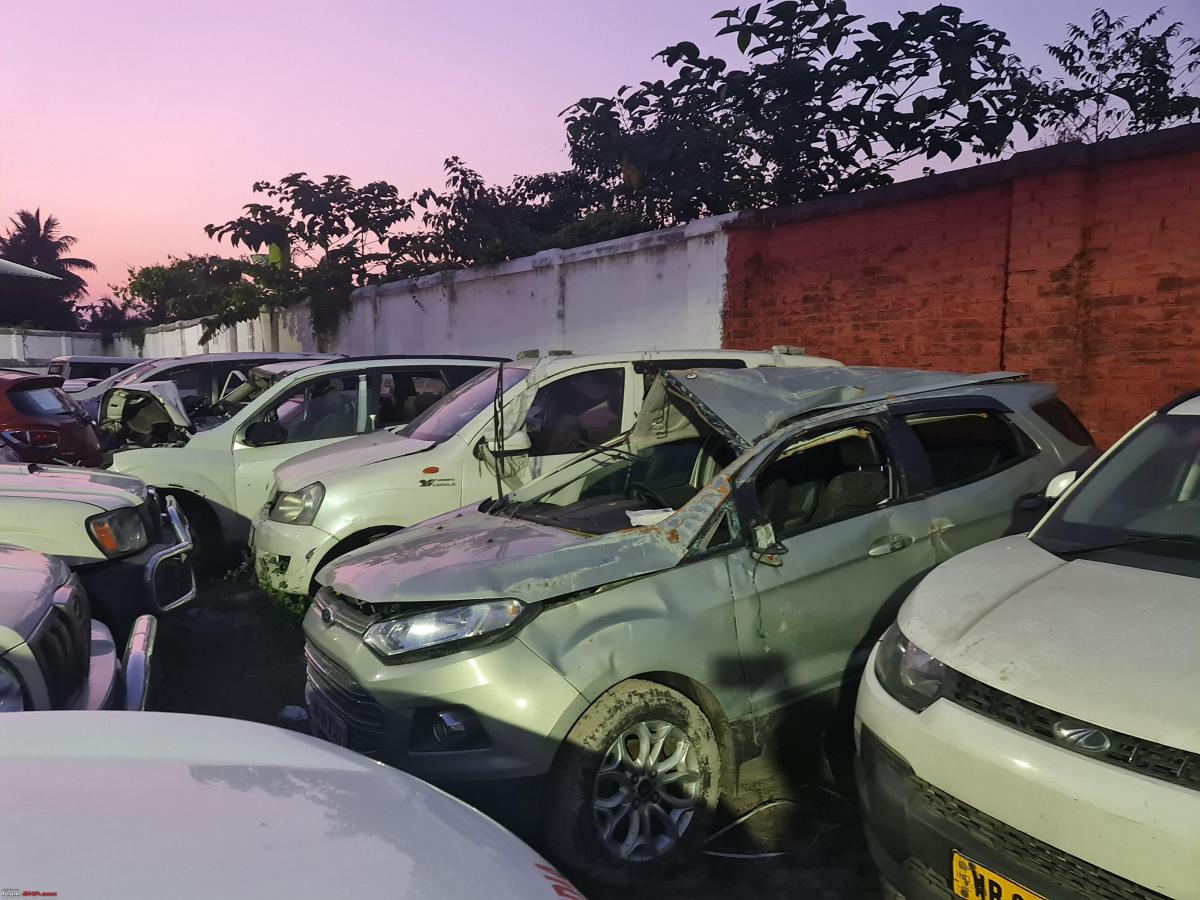

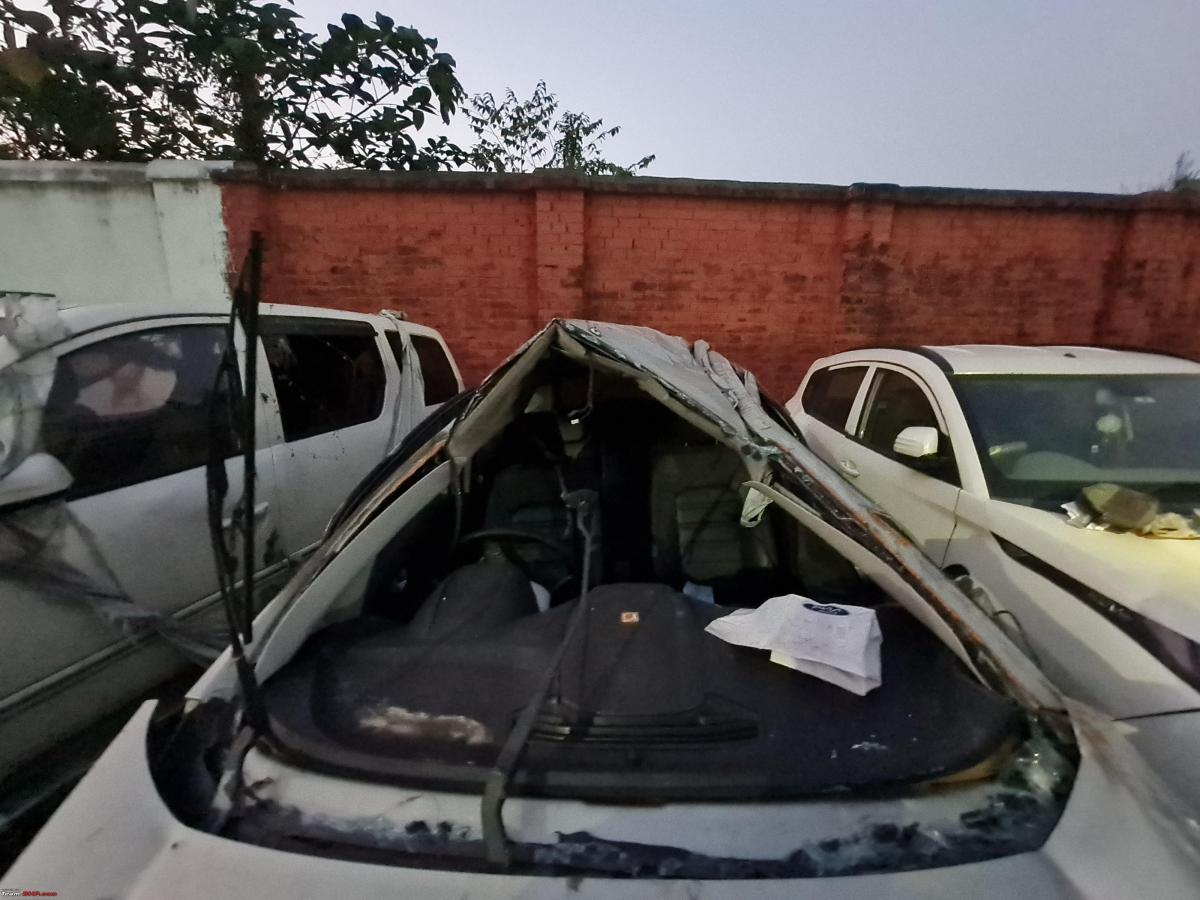
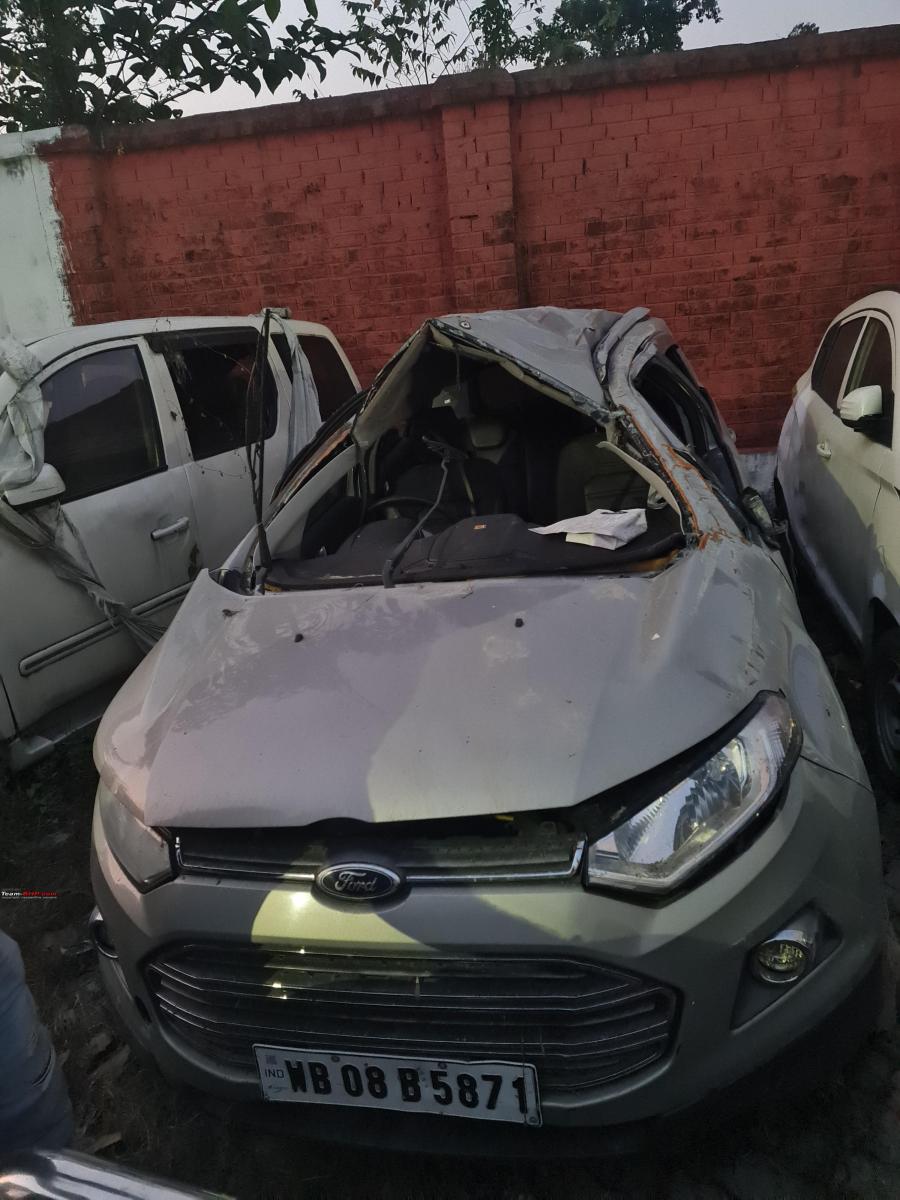


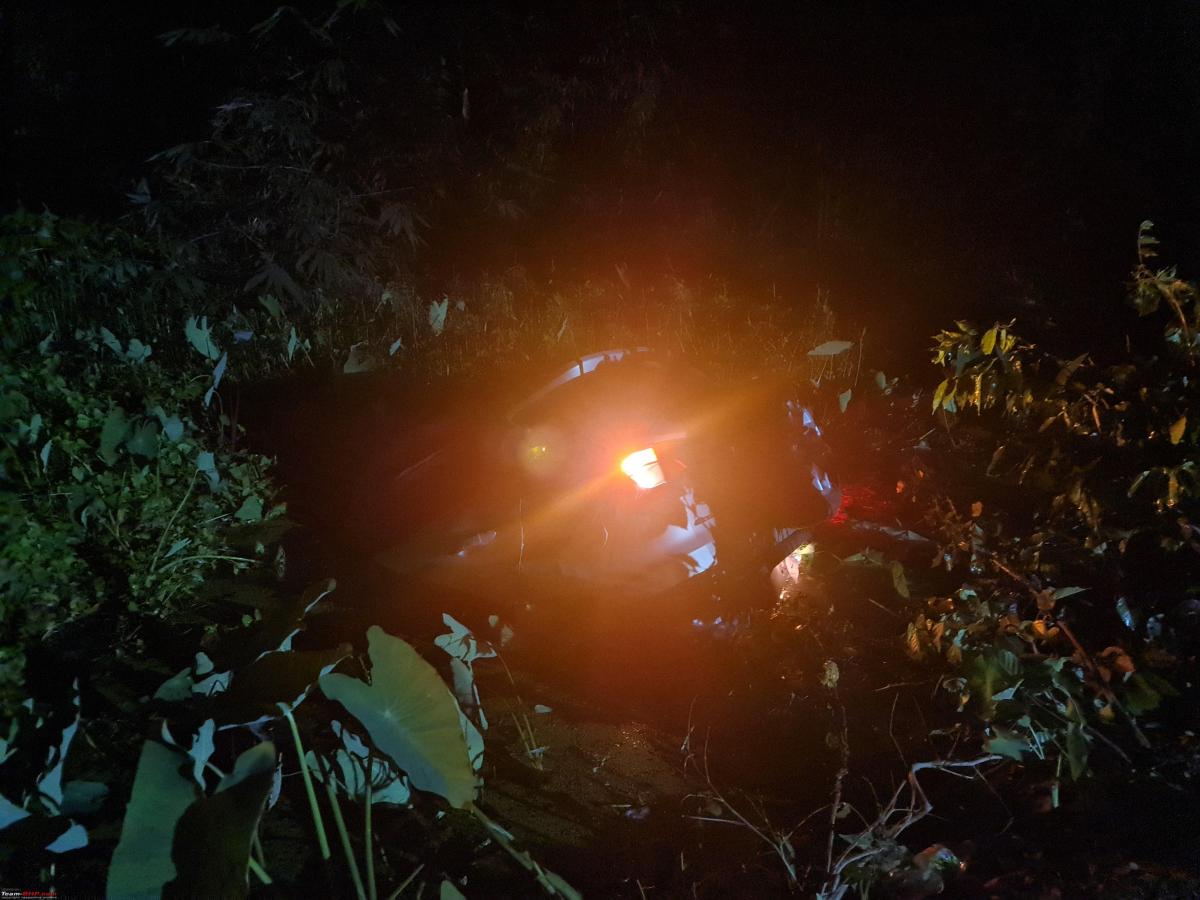
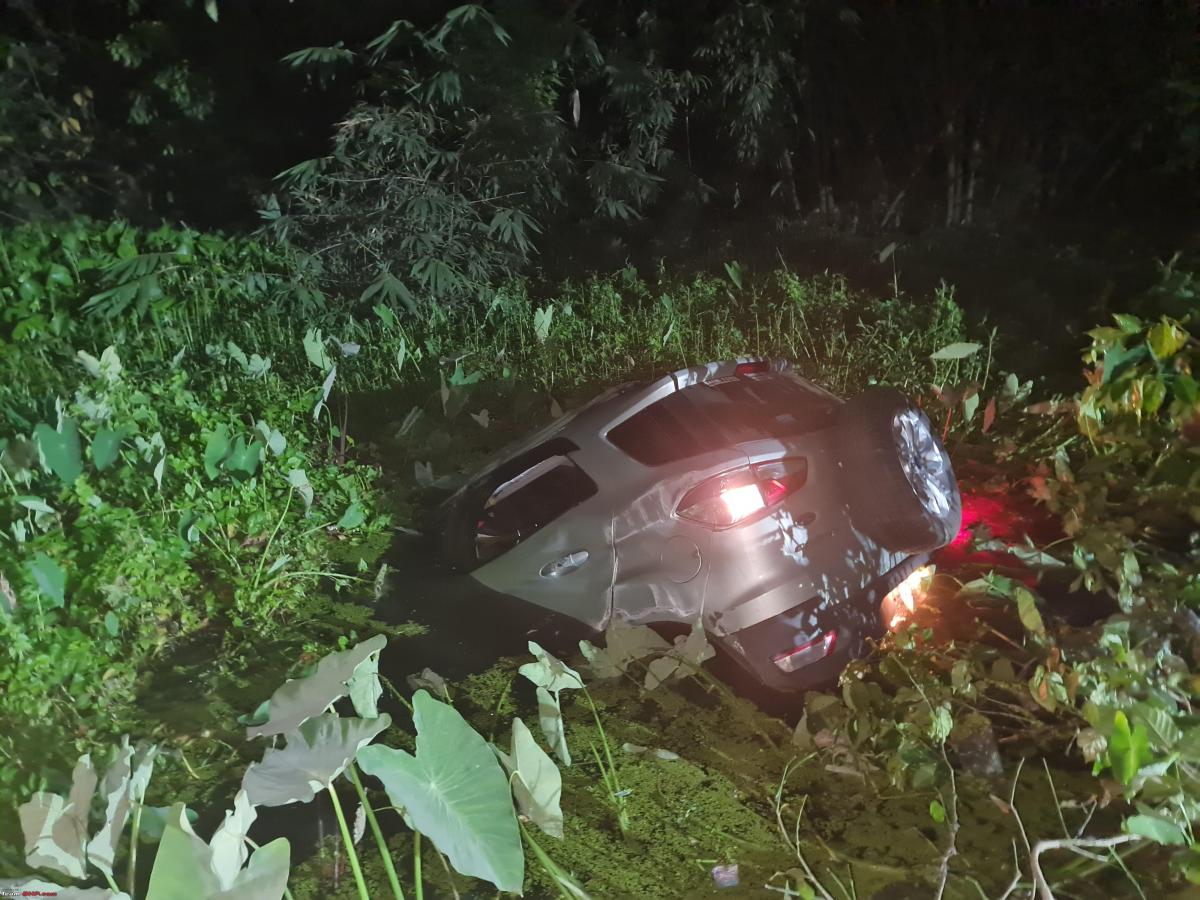

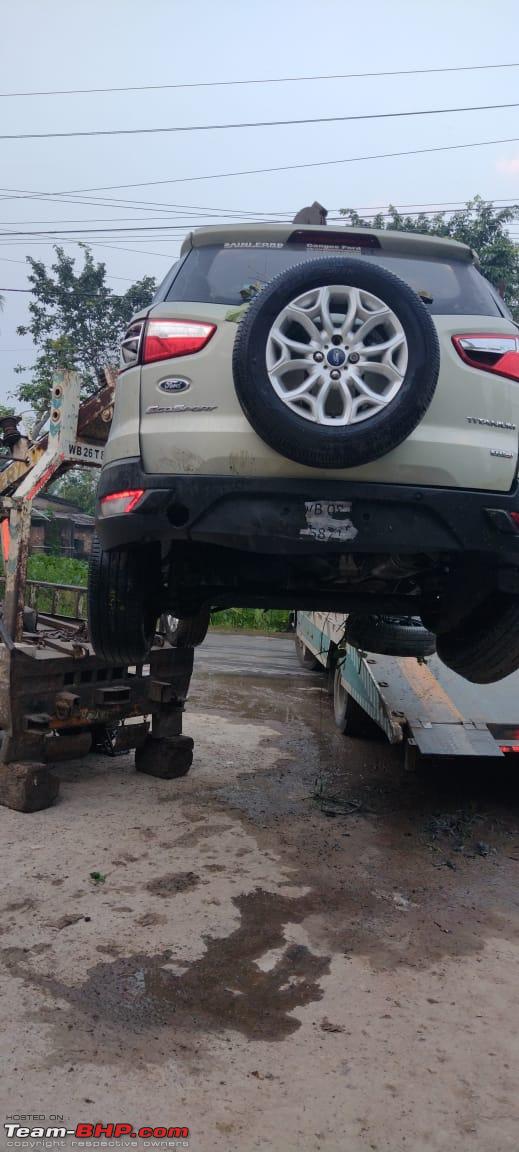
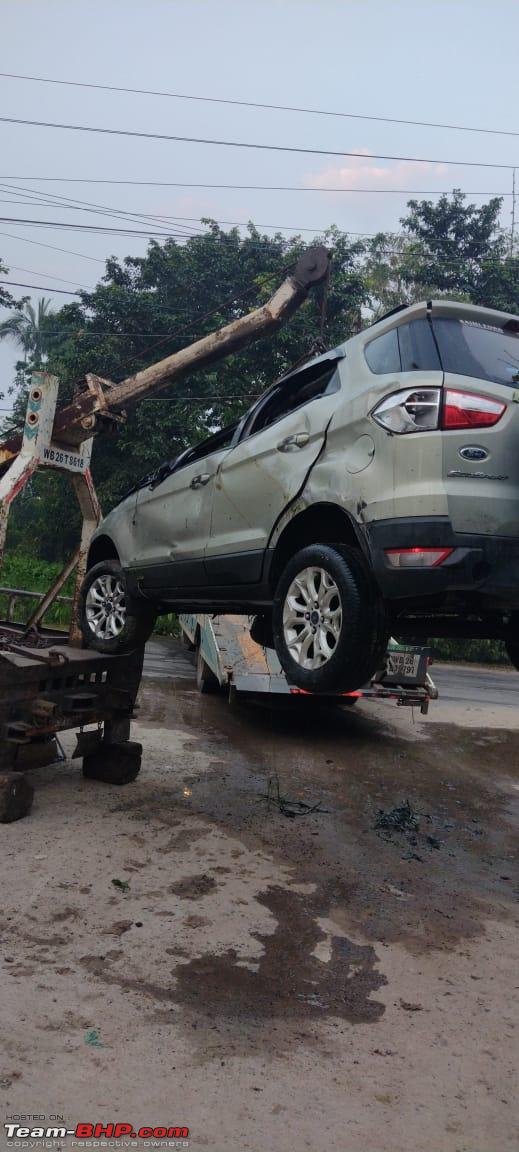
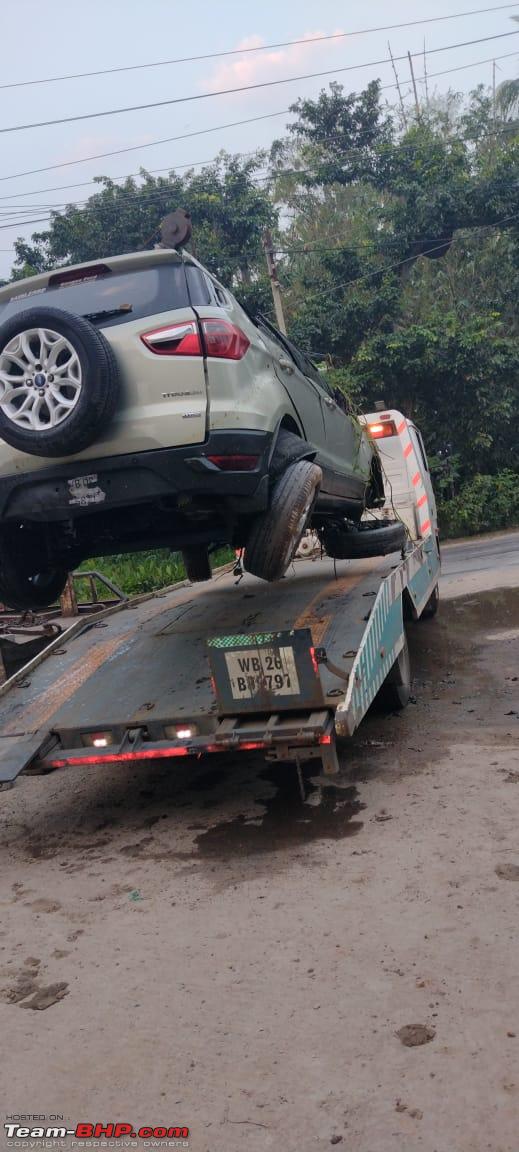
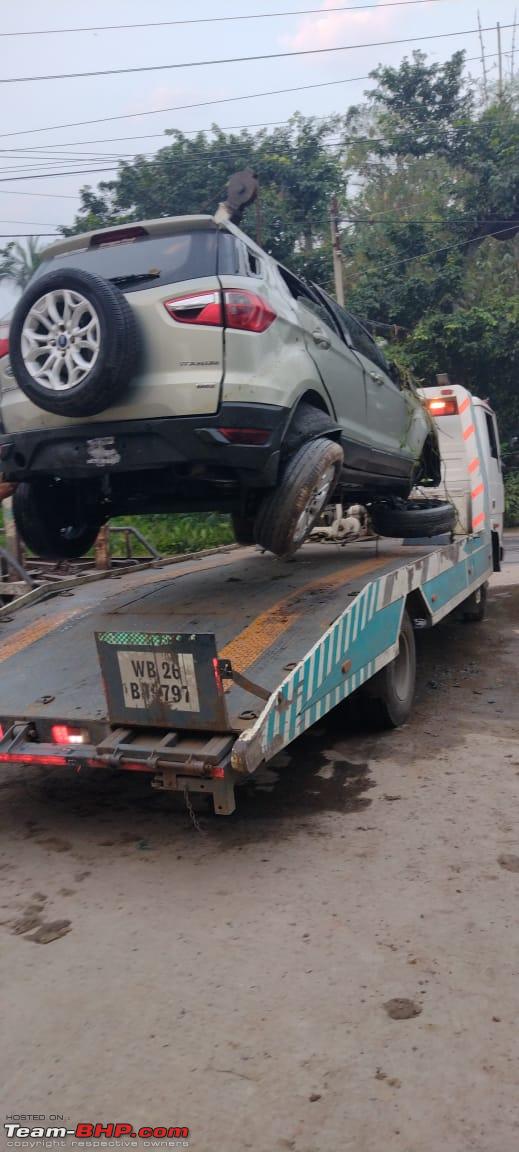
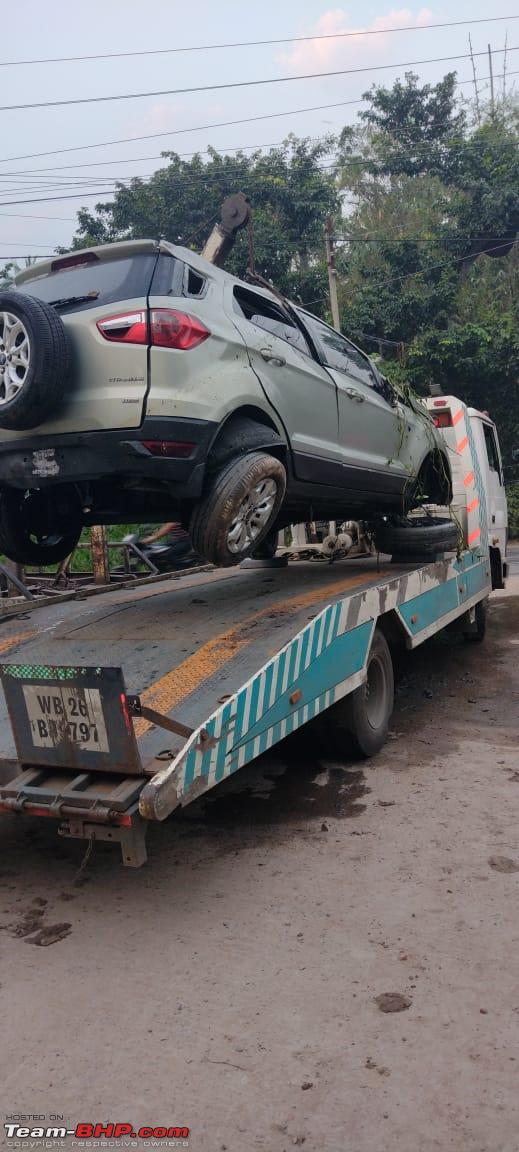
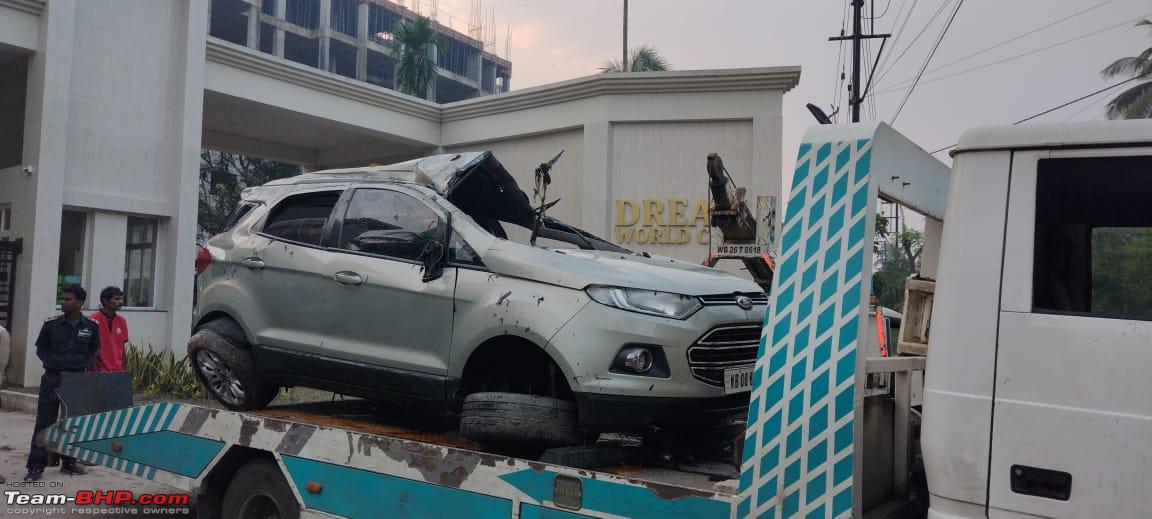
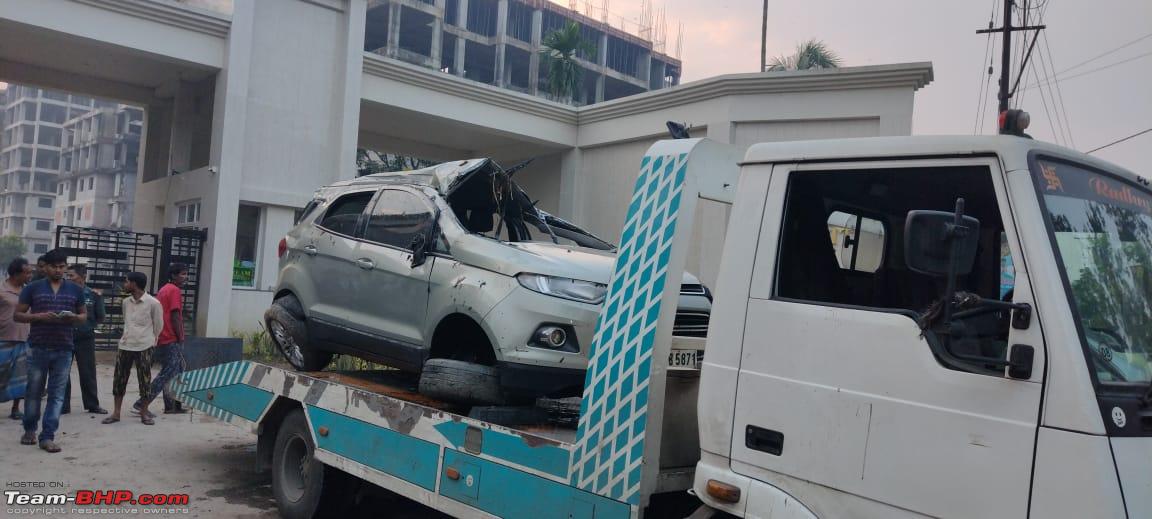
Here's what BHPian gkveda had to say on the matter:
Instances like this will reinforce the evidences that all these claimed safety features are hit or miss and never reliable. There are more than 100 cases in our forum where airbags deployment discussion have happened with heated arguments.
Forget all logical reasons and justifications from the dealers, manufacturers or R&D groups. 95% of the accident occur with 3 generic patterns. Either head-on, topples or side collision. If airbags don't deploy during any of these collisions, then, it simply means, they are not designed to address needs of the accidents. Then, what is the use of those safety features?Some one has said "We purchase things that we don't need with the money we don't have to please someone who we don't like." These safety features also falls under the same category. We purchase cars with safety features that we never intend to use by paying hefty money that we don't have, to please someone in the friend circle to boast another special feature (6 or 8 or 10 airbags )and it never works when required.
And we get brilliant explanation by dealers finally which states our driving itself was faulty and therefore airbags didn't deploy.
Below are the reasons dealers give for non deployment of airbags:
- No head-on collision
When an accident is about to happen in next 4-5 secs, Should I avoid head-on and try to escape major mishap or go and do head-on to get the airbags deployed?
- Vehicle was not running at the required speed.
So, are they expecting that I will increase the speed and acceleration when I am left with 4-5 secs for collision for airbags to deploy.
- Impact was not adequate enough for airbags to deploy.
Oh, ok. What do I do for an effective impact next time ?
Common man is very intelligent. What ever hype manufacturers, reviewers and dealership give to these safety features, he does take it with a pinch of salt.
Theoretically, is there any difference between this car and say, a Maruti 800 with respect to safety features?( let us not talk about metal thickness etc).
Here's what BHPian BoneCollector had to say on the matter:
Really glad to know you guys are safe after such a horrendous accident.
As far as the curtain airbags are concerned, I've seen a couple of Ford Ecosports at a service center with only curtain airbags deployed due to hit from the side. One car had left side airbags deployed due to T-boning and another had right side due to a side swipe by a truck. So if they say that it can get triggered only after the front airbag is deployed is all BS.
Here's what BHPian shancz had to say on the matter:
Quite an ordeal, thankfully ends in a safe and happy note.
Side airbags are supposed to deploy on side impacts, that's the objective and definition. That's why there is a side impact test and a pole test in NCAP. Check your owner's manual for deployment of airbags no further proofs needed and take it up with Ford since your service center is useless.
Check out BHPian comments for more insights and information.
News
Kia Sonet delivery delayed by 5 months; need an alternative
My son who is a car lover is turning 5 in Jan, and hence we wanted a new car around that time.
BHPian anirudhbb recently shared this with other enthusiasts.
On 28th Oct, after taking numerous test drives of the XUV300, Nexon and Sonet, all petrol non-manual variants, we finally booked the Sonet DCT. Yay!
Today, 3rd Dec, came to know that delivery is pushed to April. Nay.
Honestly don't want to wait that long. When we booked the Sonet, KIA has said delivery is mostly in Dec/Jan. My son who is a car lover is turning 5 in Jan, and hence we wanted a new car around that time.
But now it will be 6 months and even that seems uncertain.
So we are back to the search.
The XUV300 and Nexon, both are AT, though not as refined as the DCT in the Sonet, are seemingly good options other than the Sonet.
My budget is 15L on road in Bangalore.
Are there any other good options I am overlooking?
What I need (I am driving a Wagon-R for the past 7 years):
- Safety.
- Automatic/AT/CVT/DCT.
- Sunroof.
- Space.
- Good ground clearance.
- Driving pleasure: I love driving and we used to take 3-4 road trips a year pre-Covid.
- Reliable car, reliable brand (have had Maruti all my life).
- Low maintenance.
Thanks a ton!
Here's what BHPian quantobigboot had to say on the matter:
Under Rs. 15 Lakh I feel the options you have shortlisted are the best of the lot. Also remember that even the Nexon and XUV300 have considerable waiting periods, unless some political/financial influence is used. Have you looked at the S Cross? I don't recommend it often due to its outdated and bland interiors, but it will satisfy most of the needs except the sunroof and the driving pleasure part. I don't think the new one will arrive at our shores anytime soon.
If I was given a choice, I would take a long-ish TD of the Nexon and finalise it if the AMT feels sufficient.
Here's what BHPian VWAllstar had to say on the matter:
Since you are from Bangalore and have a budget of 15L, then why not look at the Nexon EV? If you don't intend to drive more than 300 KMs at one go, you should have a great package in the Nexon EV.
Apart from this, I don't see any true blue AT under 15L and especially being delivered by Jan 22. Most manufacturing would be shut post this week and will reopen only by 2nd week of January 22. Either you will have to chose from an existing inventory or let go off having delivery asap.
Here's what BHPian Shreyans_Jain had to say on the matter:
Get yourself a Honda City automatic, Gen 5 base model. It has all the essentials covered, including 4 airbags, and will just about fit your budget. If your kid is insistent on the sunroof, go for the mid trim. The car is available for immediate delivery.
Here's what BHPian IshaanIan had to say on the matter:
Well think of it as a blessing in disguise since the Sonet and Venue both perform miserably in crash tests. I would say simply forgo the sunroof requirement and get yourself an S-Cross. Test drive the vehicle before dismissing it based on uninspiring journalist's reviews. It rides and handles with far more maturity than any other vehicle in its segment and the engine+gearbox combo feels robust and smooth. Interior quality is fairly decent and the visibility and roominess of the cabin is a boon. It is also probably the only car in its class that will last you a long time until your son matures and can appreciate it You will also get massive discounts upwards of 75k on it at the moment as well as immediate delivery.
If you are enamored by touchscreens, LEDs and other such insipid bits that seem to give car makers an excuse not to put some thorough engineering behind their cars, then perhaps the MG Astor ought to be in your list of vehicles to test out.
Check out BHPian comments for more insights and information.
News
Ownership review of my Kia Sonet GTX+
The real performance of the engine and DCT becomes evident only in Sport Mode. Performance in Normal and Eco modes is very relaxed.
BHPian xks64 recently shared this with other enthusiasts.
The following posts outline some thoughts and opinions of my new* Kia Sonet GTX+ 7DCT (1.0 Turbo), purchased in November 2020.
Summary of major likes and dislikes:
Likes:
- Powertrain: Smooth and lots of power for my driving style - even fully loaded. Rides very well on long drives.
- Ergonomics are good for me and my wife - physical buttons for important stuff.
- Good visiblity and driving position. Does not feel like you are struggling to manoeuvre in the city. That said, for pure city driving I would pick something smaller/narrower.
- Feature loaded variant. Coming to India from the US market many other cars/variants feel like penny-pinching.
- Powerful AC and Cooled seats are amazing for peak summer.
- Overall well put-together package.
Dislikes:
- Price/Variant options: Top variant is quite expensive, and lower variants miss out on stuff like airbags or cruise control etc.
- No option of split rear seat - even on top variant, and non-functional roof rails.
- There seems to be a lot of doubt about reliability of a tubo+DCT.
- (The remaining points are actually minor niggles - not deal-breaker points for me)
- UVO app/server is slow and clunky. Regular people will not have the patience to deal with it. :(
- Infotainment menus are a little hard to get around - takes a while to remember where some settings are.
- No truly keyless use possible like Nexon's fitness-band style key or Ford's famous door-mounted keypad.
Prelude:
(Or how we ended up booking the Sonet)
My wife and I are based in the Hubli-Dharwad area with family in Mumbai, Pune and Bangalore. Once the lock-down began, it became apparent that having a reliable and comfortable car was going to be necessary for highway duties, and the ageing Zen in our stable was just not going to cut it. Some additional requirements were:
- Must be ergonomic for me and the Mrs. (who is slightly shorter than average and finds many cars uncomfortable), Automatic highly preferred.
- Must have a reasonably good back seat for our elderly family (not too low, good ingress/egress).
- Good ground clearance and a little off-roadability: we are outdoorsy types and often go birding.
- Flexibility of a hatchback body style: Useful for carrying outsize loads, such as bikes, or having our dog ride in the back.
- Budget of around 15lacs on road: This was not a tight constraint and we were prepared to move a little.
As such we ended up squarely in the compact SUV area, and were initially looking at the usual suspects. For about two months I obsessed over TeamBHP posts, Youtube reviews and talked to friends and family trying to create a shortlist of models/variants, and creating spreadsheets to track all this info. I also compiled a "master list" of stuff to watch out for on a test drive (link later).
The Shortlist:
From the bottom, here's our initial shortlist, and reasons why contenders were rejected outright:
- XUV300: No automatic option; Ergonomic was bad for me and absolutely terrible for the Mrs. After a 10 minute test drive she vetoed it right out.
- S-Cross: Was on the shortlist because of good reviews on reliability/highway performance. However, the high price premium for the automatic put us off.In hindsight we should have test-driven it at least, and should have seriously considered buying a manual.
- Jazz: On paper this was a serious contender, but due to slightly lower ground clearance and lukewarm powertrain it was at the bottom of the list. Also, the higher variant seemed quite over-priced.
- Nissan Kicks (Magnite & Kiger were not launched at the time): Rejected outright due to some horror stories of service experience in our region.
- Polo: Was on the shortlist simply because the Hubli area service is simply exceptional, as attested by many close friend, despite horror story reviews of other owners in MH/KA.
- Ecosport: Very nearly made it to the final shortlist. After the test drive (a colleague's vehicle) we were quite impressed with the overall vehicle and dynamics but found the rear seat a little cramped for our liking.
The cars that made it to our final "serious consideration" short-list were:
- Nexon
- Venue
- Sonet
Quick note here: We started our process in Mid-October 2020, just as things were returning to "normal-ish" and demand had started picking up. Dealers were probably keen to talk to people with definite purchase plans, not to those on the fence. Nevertheless we had an excellent experience with the dealers at Tata (Manickbag Hubli), Kia (Nagashanti Hubli) Mahindra (Sutaria Hubli). Both Hyundai dealers in Hubli would barely talk to us until we were ready to pay the booking amount, and even then would dismissively tell us about 3 month waiting periods, and the online test drive request also went un-answered. Further, this also meant that it was a sellers market - so no discounts or deals were forthcoming.
The Final List:
We did fairly detailed test drives of the Venue (DCT version belonging to a friend - dealer never responded to our request for an iMT), Sonet (DCT and iMT) and Nexon (AMT only). Our findings were pretty much in line with what the Youtube reviews had said. In the end we dropped the Venue because the top DCT version had some funny misses (no rear arm rest, no rear washer/wiper) and felt a little cramped in the back and I didn't want to settle for the iMT. For a few days we went back and forth between the Nexon and Sonet:
- Nexon (Best safety record, great room in the back and solid build, wider service network).
- Kia (Beautiful refinement, far better powertrain feel of 1.0L Turbo + DCT, and really no compromise except split rear seat), and most importantly, was much more comfortable for my wife to drive.
And finally decided to spend the additional amount and go for the Sonet.
The purchasing process was a breeze - we took delivery 2 weeks after booking (could have been a little sooner if not for a delay due to some personal work), and absolutely no discounts. The main reason we paid the higher amount for the DCT was that we wanted an automatic and did not want to miss out on the 6 airbags, and moreover we were getting delivery in just a week as opposed to 3+ months for other models
Early Experiences:
In the first two weeks we or so have driven the vehicle about 200km on short local trips as we get used to the car. Here are some observations that other reviewers have missed ( in no particular order):
- The Sonet has 3 drive modes and 3 traction modes. Only one of these 6 can be selected at a time - i.e. if you press the drive mode button it cuts off the traction mode, and so on. The assumption here seems to be that the traction modes (Sand / Mud / Snow) are for off-road use and the Drive Modes are for on-road use.
- Connected Car Tech: I've always felt this is a bit of a fancy gimmick, but last week there was a situation where being able to unlock the car from my phone was a huge convenience (without it I would have had to walk 10 mins to just to get the key). One should remember, however, that for this to work, your phone *and* your car must have data connectivity. I wish more cars would come with a wearable key / band like the Nexon.
- Ventilated Seats: Are absolutely AWESOME! Even in the mild heat of of a sunny day it makes a big difference, I'm sure I will feel it even more during peak summer.
- The sound mood lamps are just a gimmick - as I had expected. Basically very mild RGB LED accent lights in the door and dash area.
- There is no dedicated SD/USB slot in the car. In the rare case that I do not connect my phone, there is no music other than AM/FM. WIll maybe keep a USB drive with MP3s in the car.
- [Rant] It's 2020 - why don't we all have wireless Android Auto / phone projection yet?
- Many reviewers have said that the Sonet rear seat space is a little less. There are no "big/tall" people in my family and we find it plenty roomy - even though it is slightly less wide compared to the Nexon.
- The Sonet, like many other cars today, has purely cosmetic roof rails. US/EU cars have loadable roof rails that can carry oversize items like canoes or skis (neither of which I foresee needing). Will see how much this impacts anything in the future.
- The real performance of the engine and DCT becomes evident only in Sport Mode. Performance in Normal and Eco modes is very relaxed.
- We had almost no choice of color, and we were not too particular on it, which is why we were able to get it very quickly.
- It appears that there is no play/pause button on the steering; only mute. Very annoying when listening to podcasts.
Photos:
The front 3/4 view: arguably the best look of the Sonet:
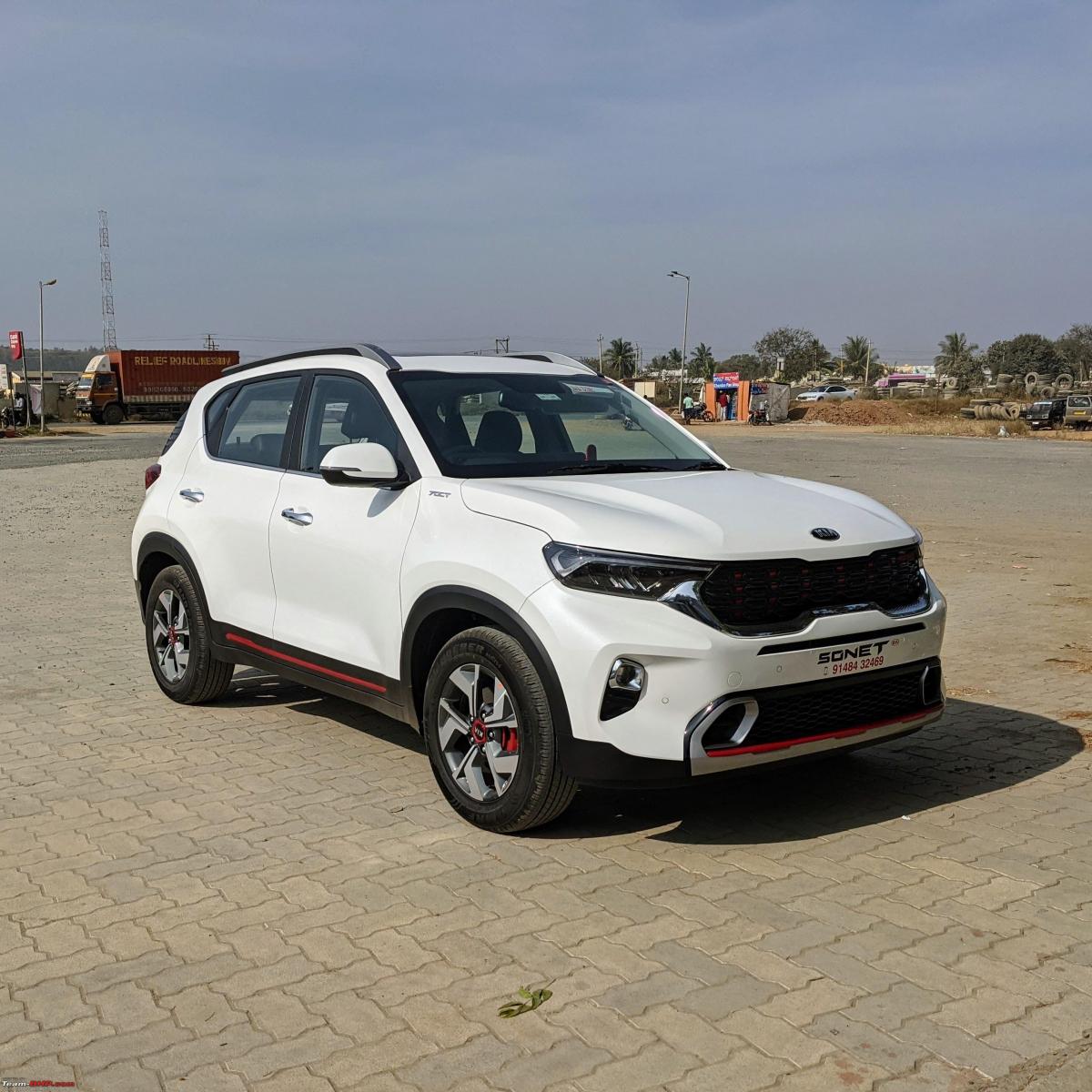
Here is the rear 3/4 view of the Sonet:

Full Frontal. I've liked the front fascia/grill for most Kia models, this one is no exception:
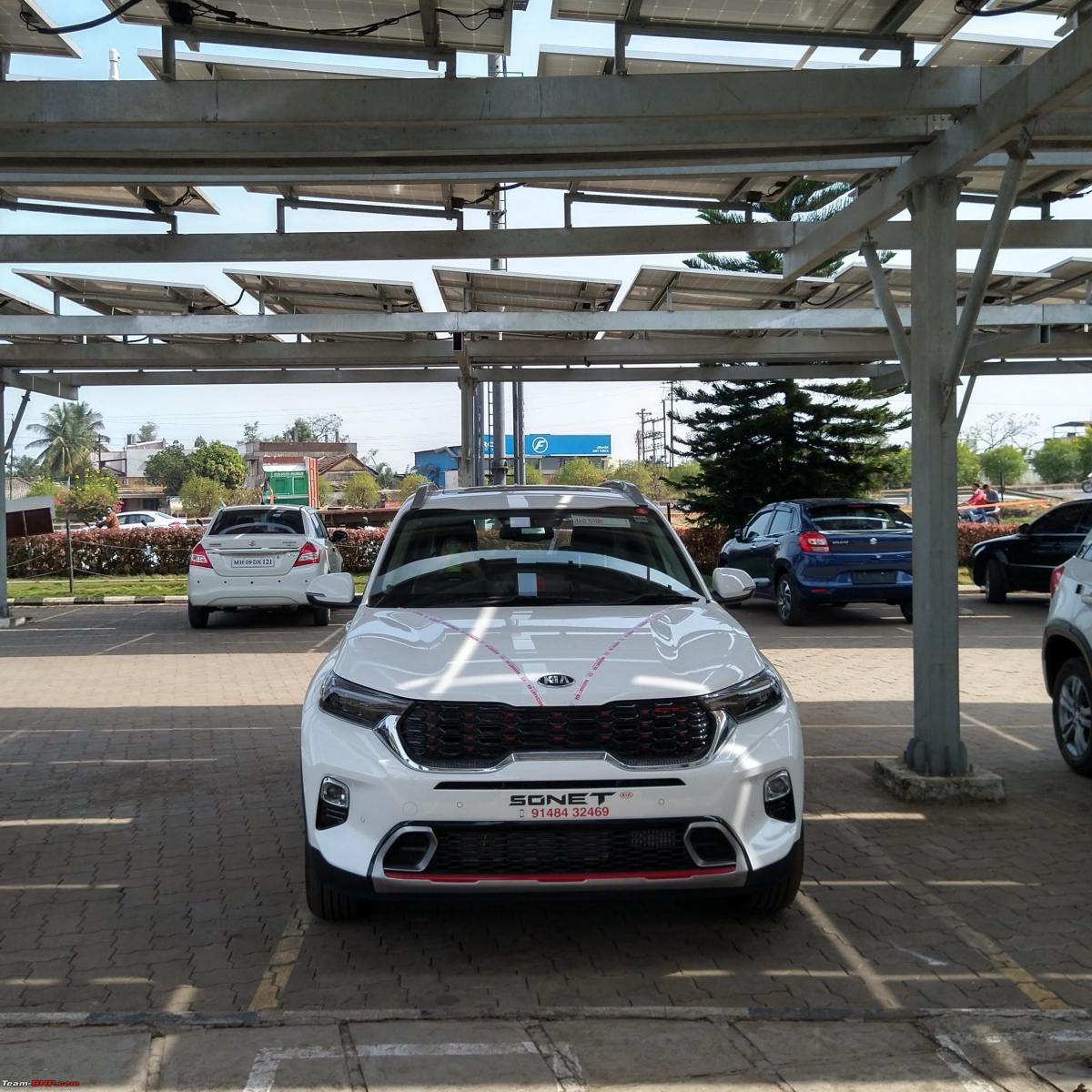
On a birdwatching trip in Hessaraghatta - making full use of the high ground clearance and "SUV" claims:
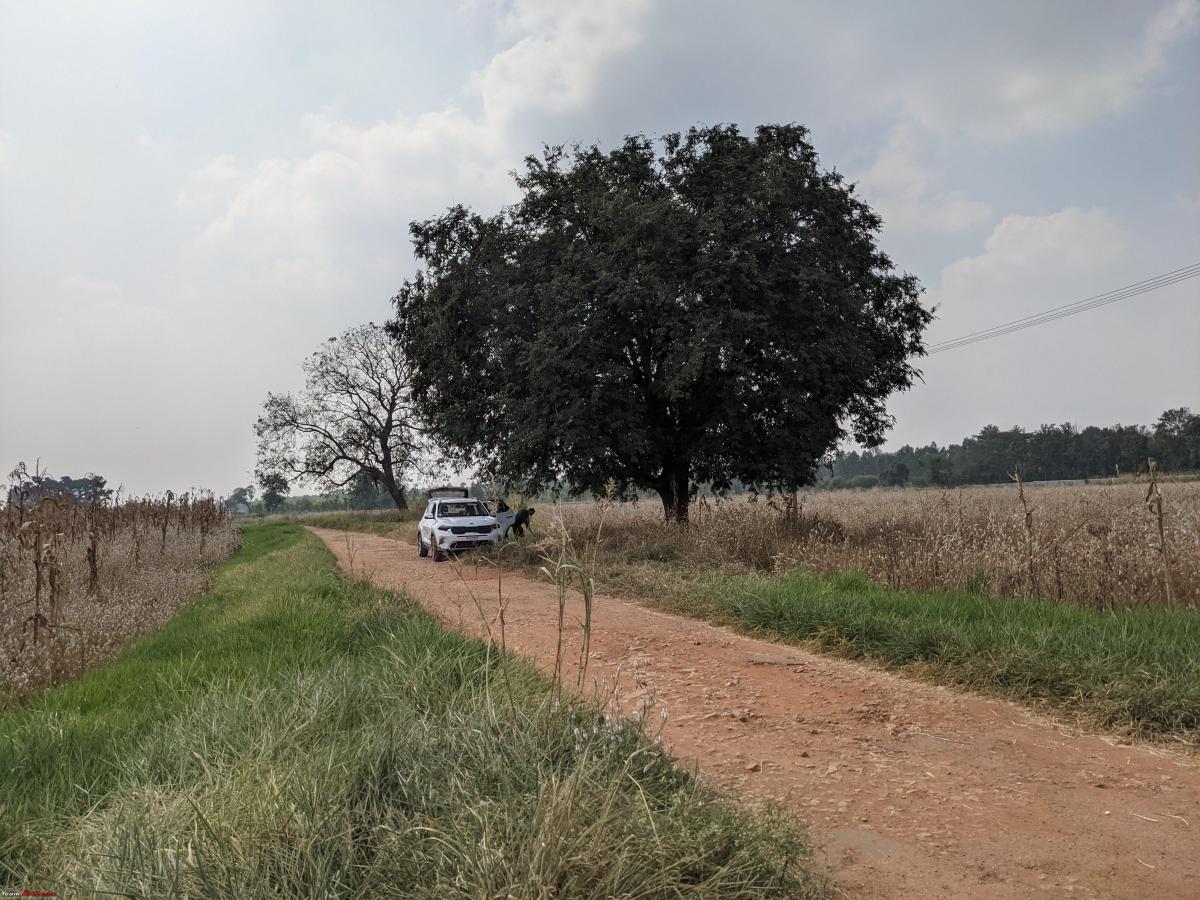
His royal highness riding in the back. With the rear seat folded down it makes a nice full flat bed and the window ledge is at a nice eye-level. - I am just missing having split-folding seats:
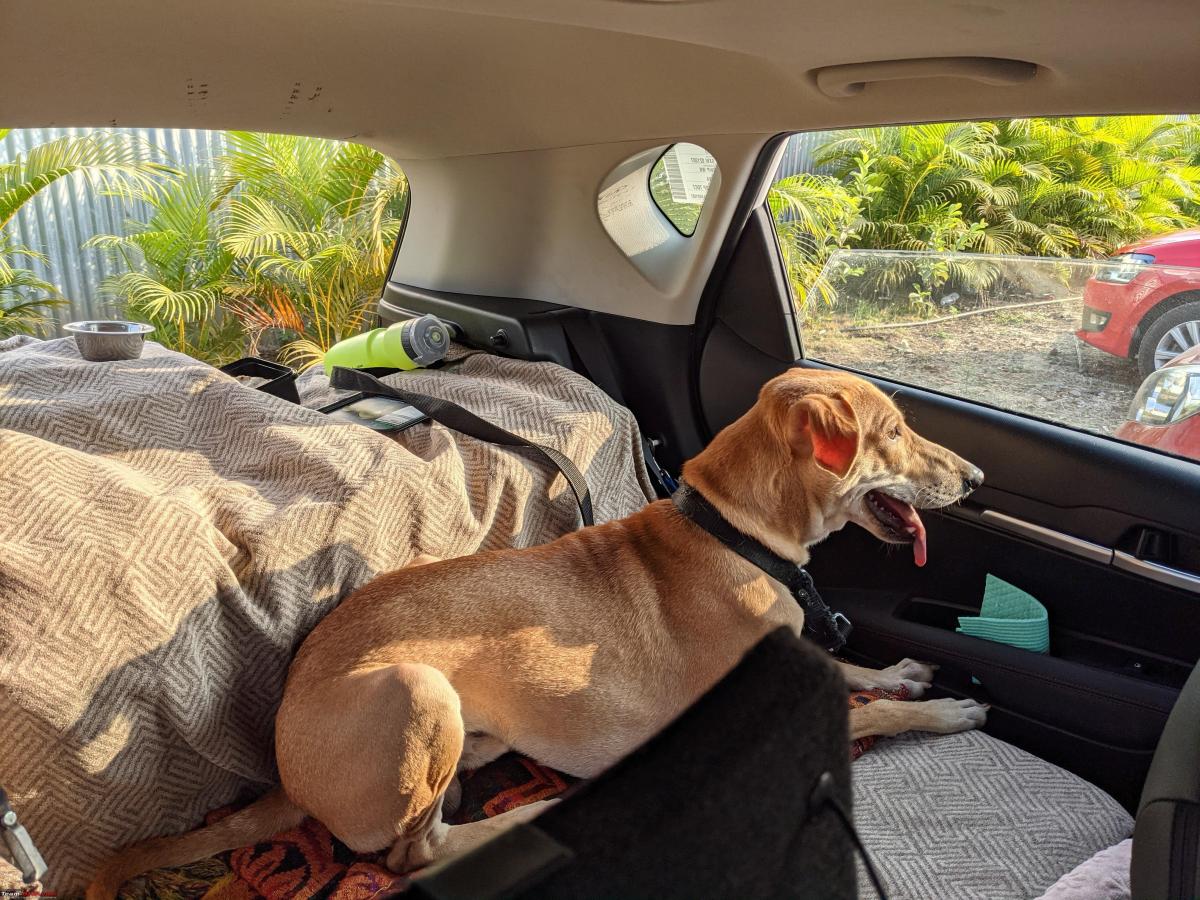
The whole reason I did not get a sedan was to have the ability to carry bikes and other gear. There are two bikes loaded up at the moment. With front wheel off and handlebar turned, the bikes fit vertically. The fact that the rear seat does not fold flat is certainly annoying, but manageable:

The LED lights look great, the auto lights / follow-home lights are particularly useful:
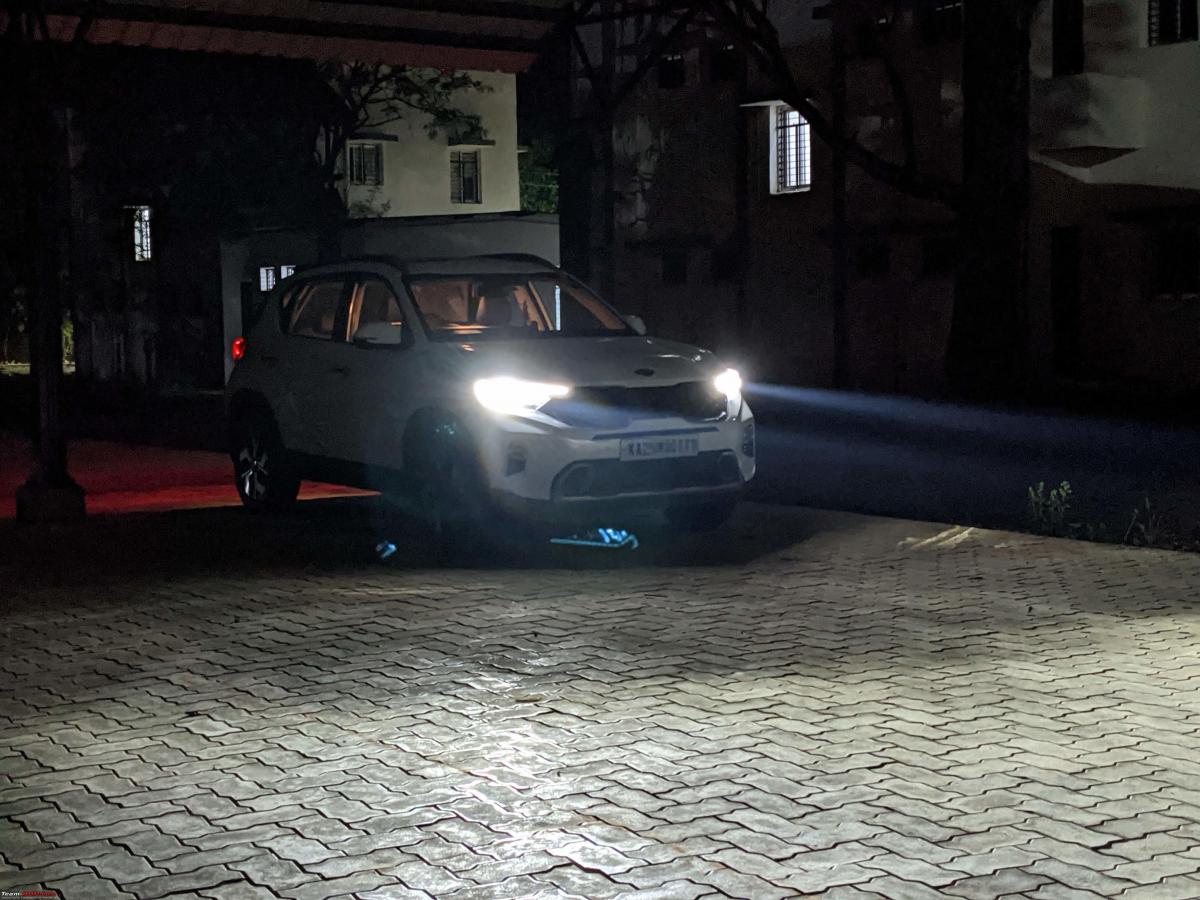
Due to lockdowns and work commitments the car did just over 1000km between Jan '21 to September '21. Living on campus there was no need to commute as well - hence the ridiculously low mileage:
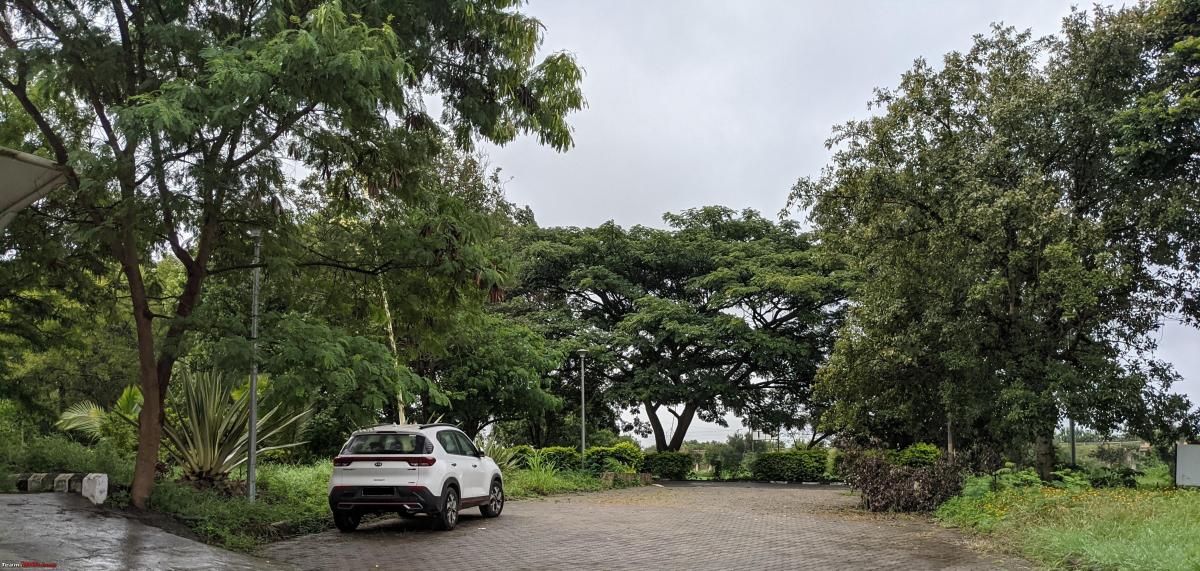
Finally when things had opened up in end of Sep / Oct we took a small trip into the Western Ghats with family (2 dogs included). Car performed flawlessly - and having the sunroof open while driving through the forests was a nice experience:

Continue reading xks64's review of his Kia Sonet GTX+ for BHPian comments, insights and more information.
- Tags:
- Indian
- Kia India
- Kia
- Kia Sonet
- Compact SUV
News
Rumour: Next-gen Suzuki Swift to spawn a crossover
The Swift Sport-based crossover could be powered by a 1.4L turbo-petrol mild-hybrid engine.
According to a media report, Suzuki plans to introduce a small crossover based on the next-generation Swift Sport. It could arrive by 2024.
The next-generation Suzuki Swift will be based on the updated Heartect platform. It is expected to debut sometime next year. The high-performance version called the Swift Sport is said to debut in 2023.
The Swift Sport could be powered by a 1.4-litre turbo-petrol engine paired with a 48V mild-hybrid system. The car will also feature a few chassis upgrades, including a stiffer suspension setup.
While details about the new crossover are scarce, the car could use the same 1.4-litre mild-hybrid engine as the Swift Sport, paired with Suzuki's AllGrip all-wheel-drive system.
Suzuki's new Swift-based crossover could be positioned between the Ignis and Vitara. It is still unclear if Maruti Suzuki would offer it in India.
Source: Bestcarweb
- Tags:
- Indian
- Swift
- Compact SUV
News
Tata Punch vs Maruti Vitara Brezza vs Hyundai Venue vs Others
The Tata Punch is lovely in every area, except for the one that matters the most = under the hood
BHPian Aditya recently shared this with other enthusiasts.
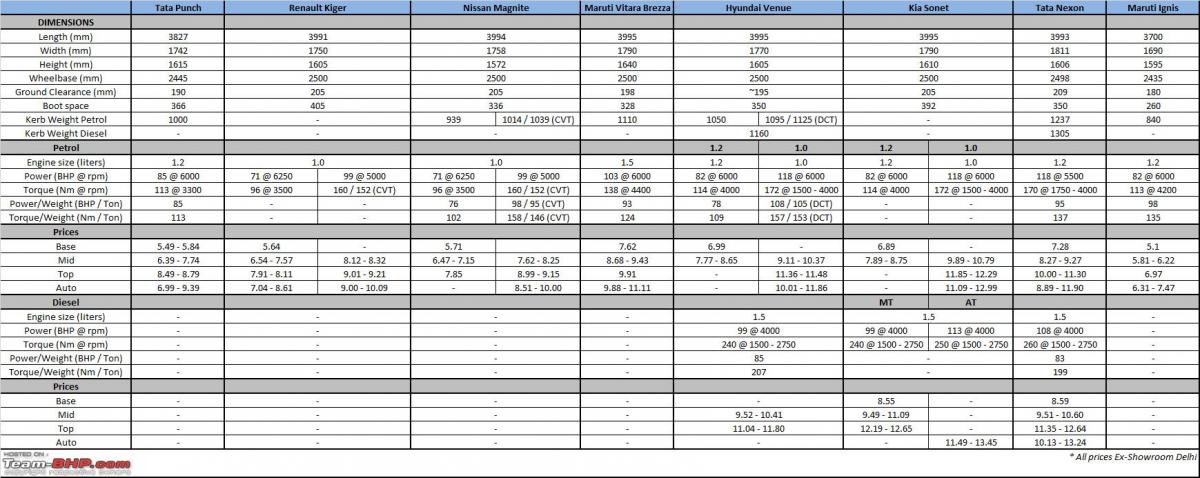
Tata Punch
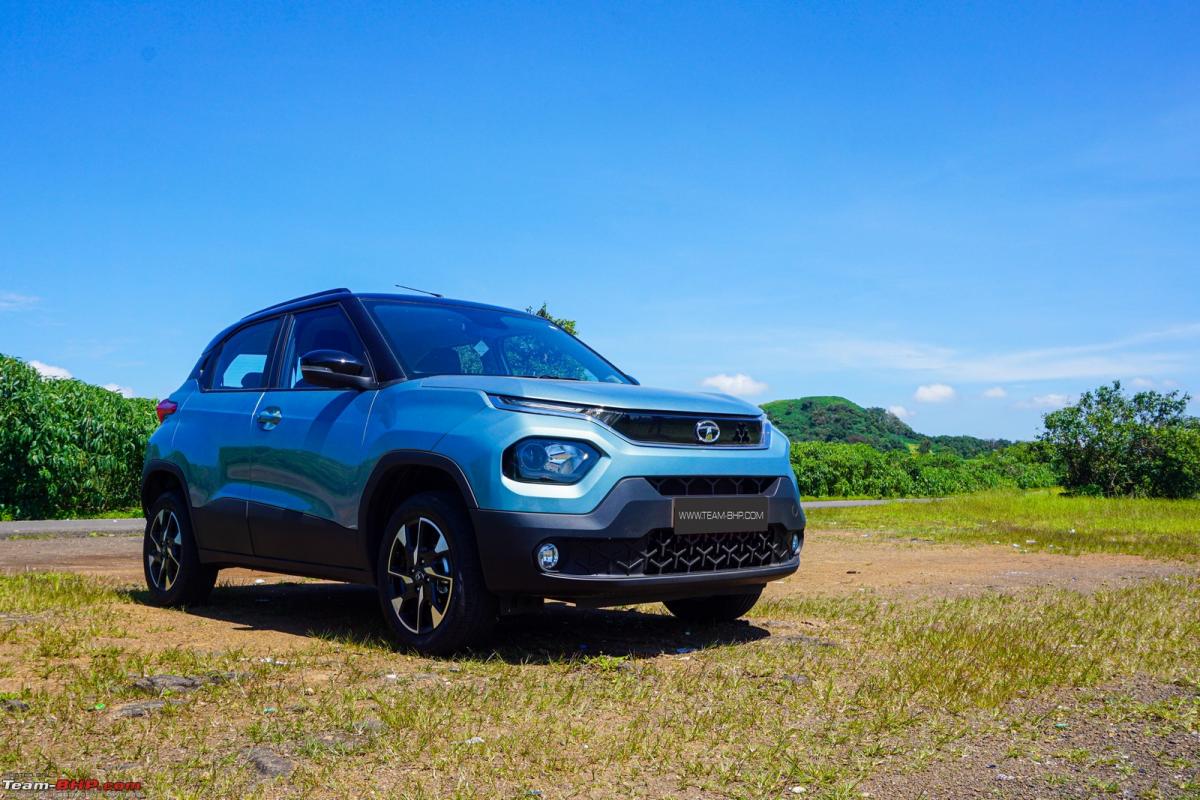
What you'll like:
- Snazzy styling! We love the mini-Harrier face and tight rear end
- Well-designed & practical cabin with enough space for 4 adults
- 366-litre boot is accommodating
- 1.2L NA petrol offers good driveability in the city. Performance is acceptable <90 km/h
- Sorted road manners & reassuring high-speed stability
- Enjoyable Harman 6-speaker ICE. One of the better systems in this segment\
- Features such as auto headlamps & wipers, cruise control, Traction Pro (AMT), cooled glovebox…with factory customization packs too
- A full 5-stars in the GNCAP! Safety package includes dual airbags, CSC, brake sway control, ISOFIX etc.
What you won't:
- 1.2L NA petrol’s highway performance is weak. At 100 km/h & up, more noise than action
- Suspension has a firm tune (R16 variants). It is compliant & liveable, but you do feel bad roads
- Jerky and slow AMT gearbox when competitors offer you smoother CVTs and torque converters
- 3-cylinder petrol cannot match the competition’s 4-cylinders in refinement & NVH
- No turbo petrol or diesel option. Period. Rivals & other Tata cars offer both
- Cabin width makes 4 adults welcome, not 5
- Some missing goodies such as an auto-dimming IRVM, split rear seat, rear AC vents, full-size spare…
- Tata's after-sales service quality is a hit or miss. Remains a gamble
Renault Kiger
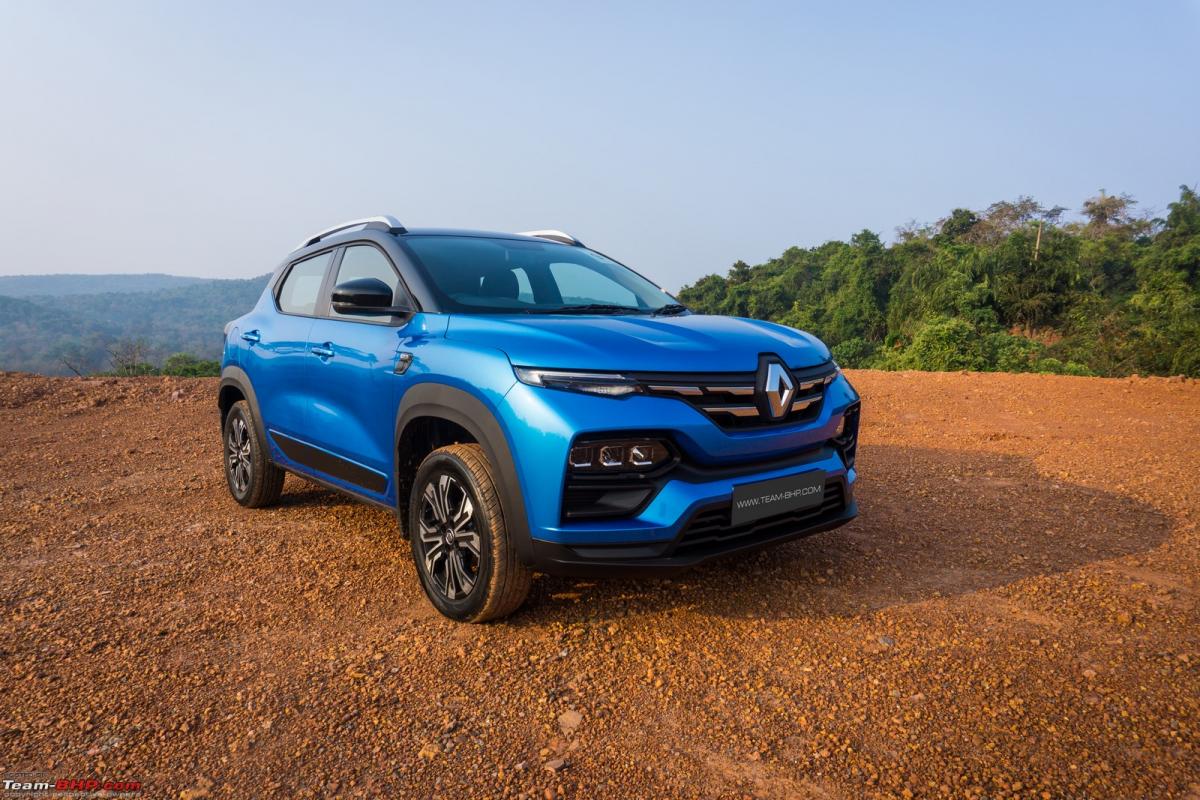
Nissan Magnite
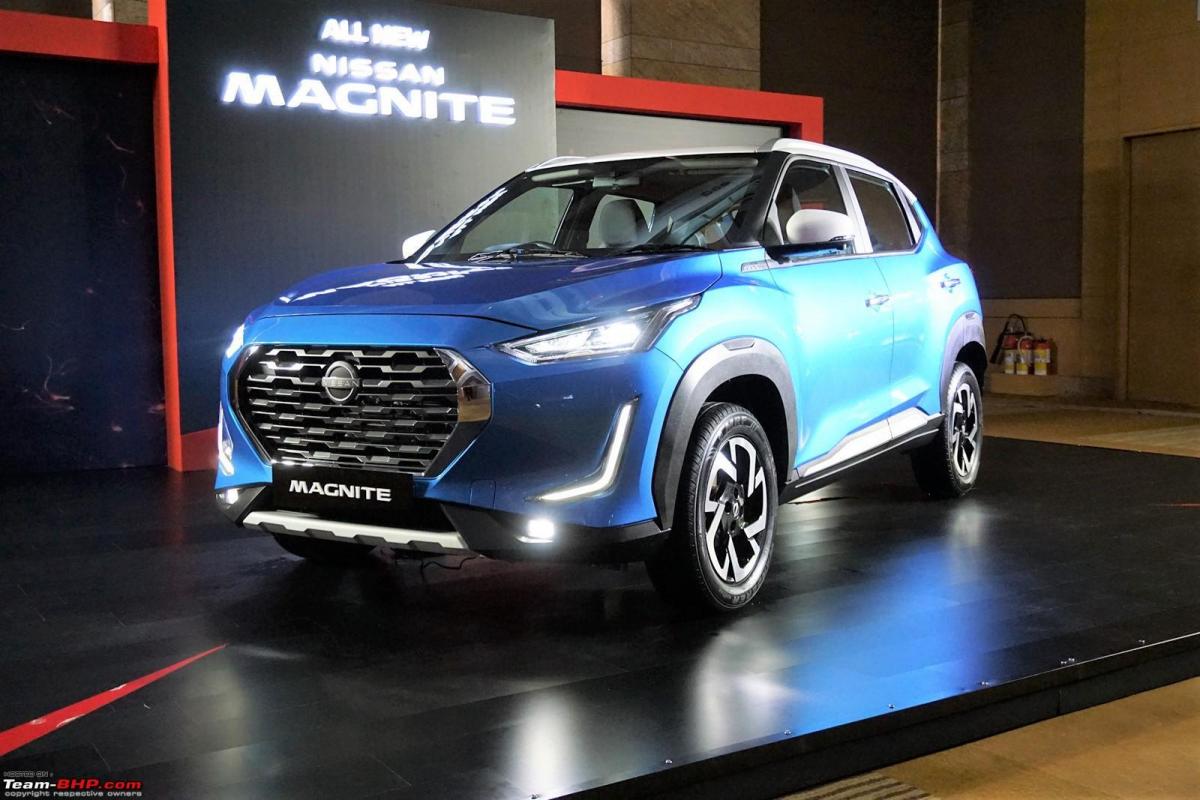
What you'll like:
- The Magnite looks really good…that handsome face is a head-turner
- Sheer value-for-money pricing. Turbo-petrol with a proper AT under 10 lakhs!
- Peppy performance from the Magnite’s 1.0L turbo-petrol engine
- Smooth well-tuned CVT in a sea of jerky AMTs. Has Sport and L modes too
- Healthy legroom for rear passengers. Space packaging is brilliant
- Impressive kit (cruise control, LED headlamps, rear air-con vents, 360-degree camera, wireless charger, wireless Android Auto & Apple CarPlay)
- 205 mm of ground clearance is more than enough for any kind of bad roads
- Safety kit includes ESP, TPMS, ABS, EBD & hill start assist
- Base variant also gets a reasonable kit, including a rear wiper. It’s not poverty-spec
What you won't:
- Stiff & basic ride quality. You feel each and everything on the road
- The Magnite is built to a cost and it does show, especially in the budget-grade cabin
- Lower variants’ 1.0L naturally-aspirated petrol is a boring, unimpressive engine
- Clunky, firm MT gearshift & a clutch pedal that has more weight than it should
- No diesel option available on the Nissan Magnite
- Cabin is narrower than some competitors. Narrow width makes it best for 4 adults
- Missing features such as an auto-dimming IRVM, full-size spare tyre…
- Doesn't have the finesse or quality of premium crossovers like the XUV300, Sonet etc.
- Nissan's tiny dealership network & lousy after-sales quality
Maruti Vitara Brezza
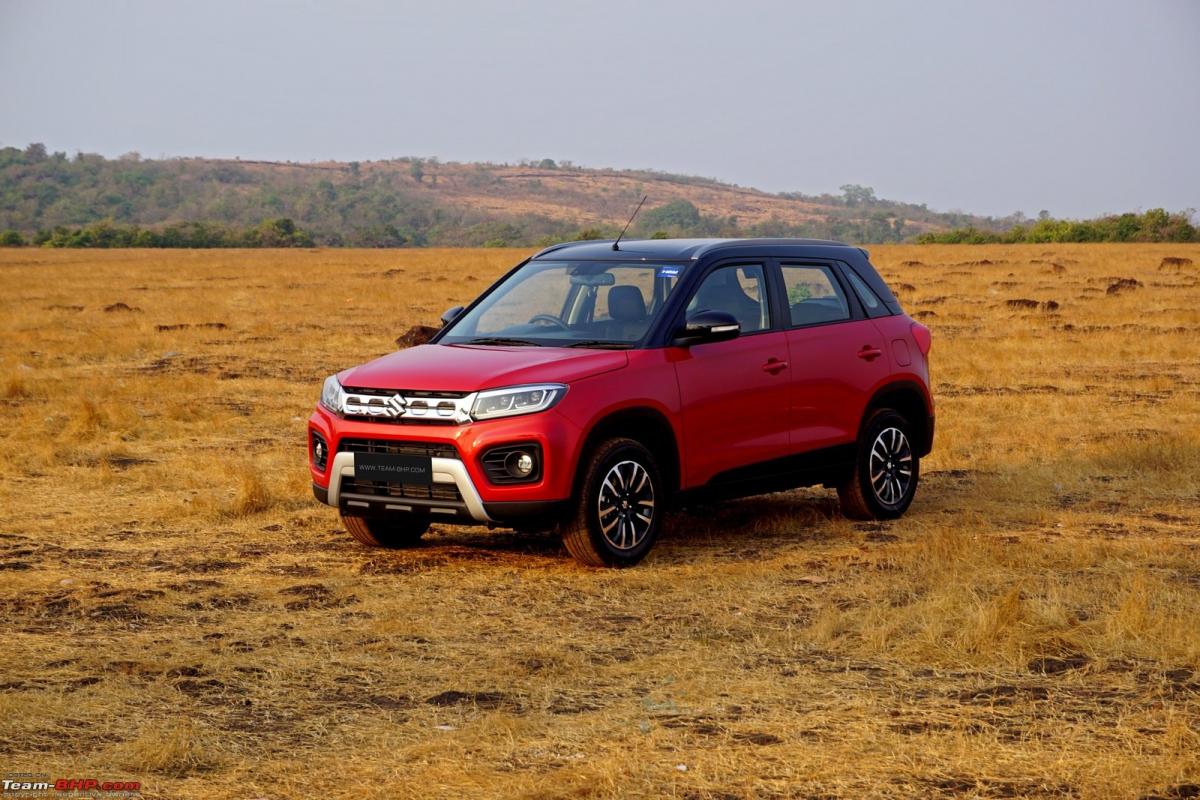
What you’ll like:
- A well-rounded Compact SUV with mature styling & mass-market appeal
- Competent 1.5L petrol offers excellent driveability & practicality
- Smooth torque-converter AT replaces the jerky old AMT. Gets SHVS tech
- Well-mannered suspension riding on big 215/60 R16 tyres. Good ground clearance as well
- Decent cabin space for a sub-4 meter car. Lots of storage & a powerful air-con too
- Features such as auto LED headlamps, auto wipers, cruise control, 7" touchscreen ICE etc.
- Dual airbags & ABS are standard. The pre-facelift version received a 4-star GNCAP safety rating
- Maruti’s excellent after-sales service, wide dealer network & fuss-free ownership experiences
What you won’t:
- No diesel option! Maruti’s BS6 1.5L diesel engine is still some time away
- This 1.5L petrol motor is uninvolving to drive. Enthusiasts, look elsewhere
- 4-speed Automatic gearbox feels old & outdated. No manual mode or paddle shifters either
- With the new 1.5L petrol, the car has lost its relative VFM positioning in the segment
- AT option commands a steep Rs. 1.2 lakh ex-showroom premium!
- Ordinary interior quality and design. The game has moved on with newer competitors
- Missing features by 2020 standards (6 airbags, sunroof, leather seats etc.)
- Boot has a practical layout but is still the 2nd smallest in the segment @ 328-litres
Hyundai Venue
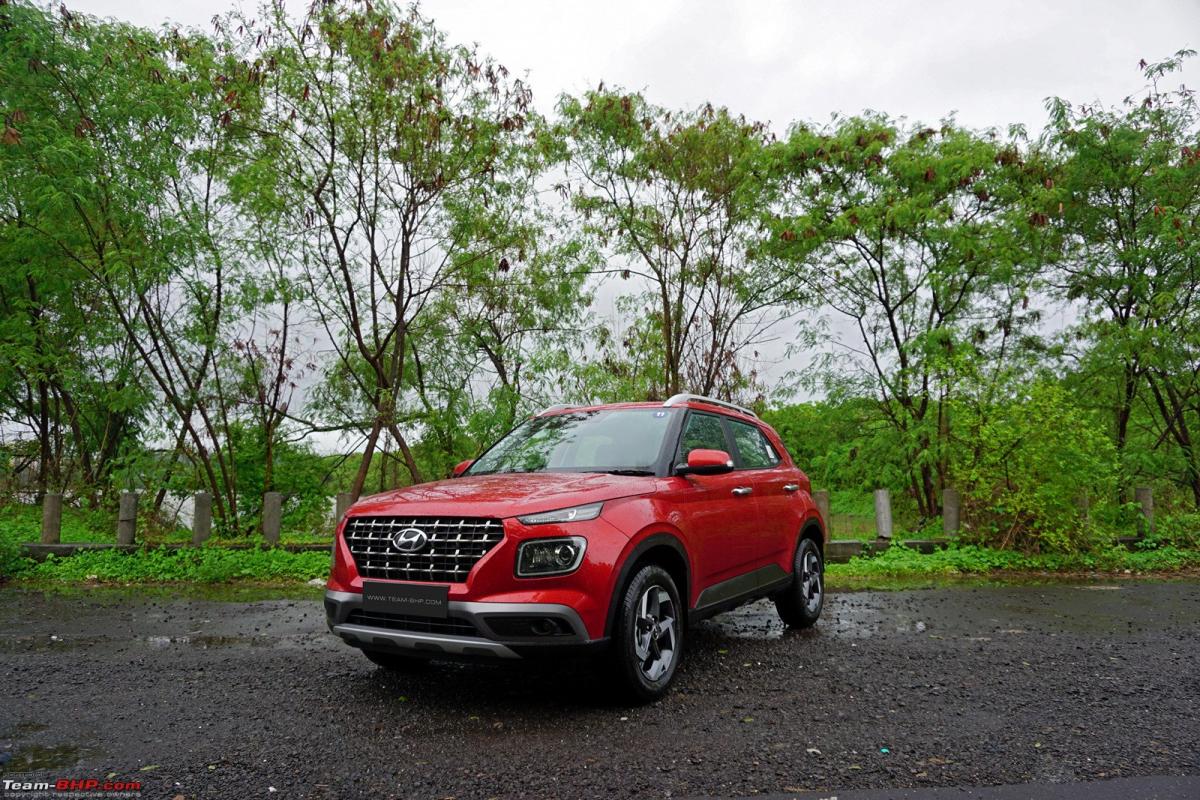
What you'll like:
- A mini-Creta in almost every way! Same formula, in a smaller package
- Precise build & quality (including interiors) are easily among the segment-best
- Competent engines mated to slick gearboxes
- Fast shifting dual-clutch Automatic gearbox available
- Balanced road manners. Very easy to drive too
- Loaded to the gills with equipment (sunroof, Blue Link telematics, cabin air purifier etc.)
- Top safety equipment includes 6 airbags, ESP, HSA and more
- Hyundai's competent after-sales & fuss-free ownership experiences
What you won't:
- Diminutive street presence. Looks more hatchback than SUV from some angles, especially the rear
- Strictly a 4-seater. All-black interior makes it cosy. Some competitors offer more spacious cabins
- Missing kit (auto wipers, auto-dimming IRVM, steering reach adjustment...)
- DCT doesn't have a sport mode or paddle shifters. Fingers crossed on its long-term reliability
- Weirdly, the highest SX(O) trim doesn't get the DCT or dual-tone colour options
- Some variant mishaps = e.g. crucial rear wash + wipe just on the topmost trim!
- AT only on the petrol, not the diesel. XUV300 & Nexon have Diesel ATs
Kia Sonet
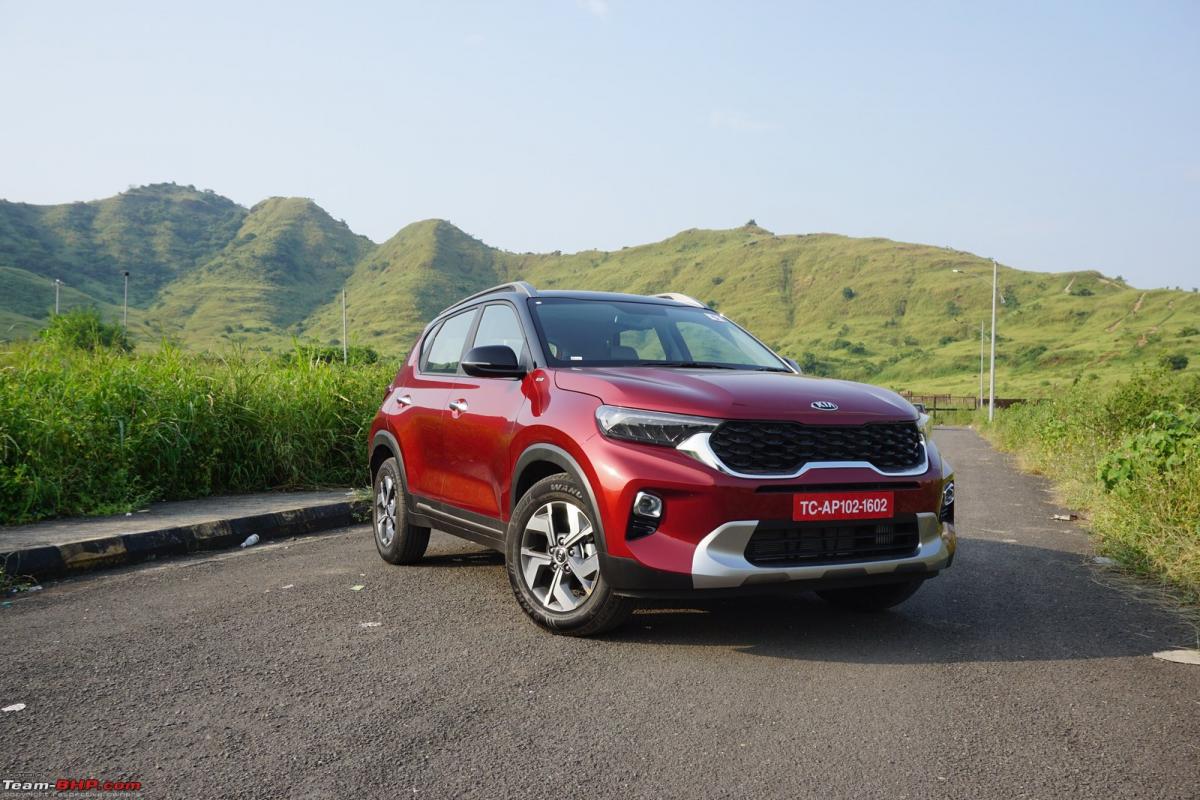
What you'll like:
- A mini-Seltos in almost every way! Same formula, in a smaller package
- Sharp & handsome styling. In our opinion, this is the best-looking Compact SUV
- Excellent spread of powertrains including a fast & enjoyable turbo-petrol
- Diesel AT is fantastic; the only smooth torque-converter gearbox in a sea of AMTs
- Well-tuned suspension offers a good balance between ride & handling. 205 mm GC too
- Top safety package includes 6 airbags, ESP, HSA, TPMS etc.
- Very enjoyable 7-speaker Bose sound system
- Impressive kit (ventilated seats, sunroof, auto LED headlamps, cruise control, wireless charger)
What you won't:
- Rear seat legroom is just adequate, while its limited width makes the Sonet a 4-seater
- Top variants are pricey! More expensive than its sibling, the Hyundai Venue too
- Some misses ( 60:40 rear seat split, auto wipers, steering reach adjustment, illuminated window buttons, full-size spare tyre on top trims…)
- Dual-clutch ATs (like the Petrol DCT) have a history of poor reliability in India
- As always with Kia, the variant spread is tough to figure out. Good luck finding your perfect Sonet!
- The tasty 1.0L turbo-petrol doesn’t come with a manual gearbox. Venue has that option
- Waiting periods are a couple of months-long for some trims
Tata Nexon
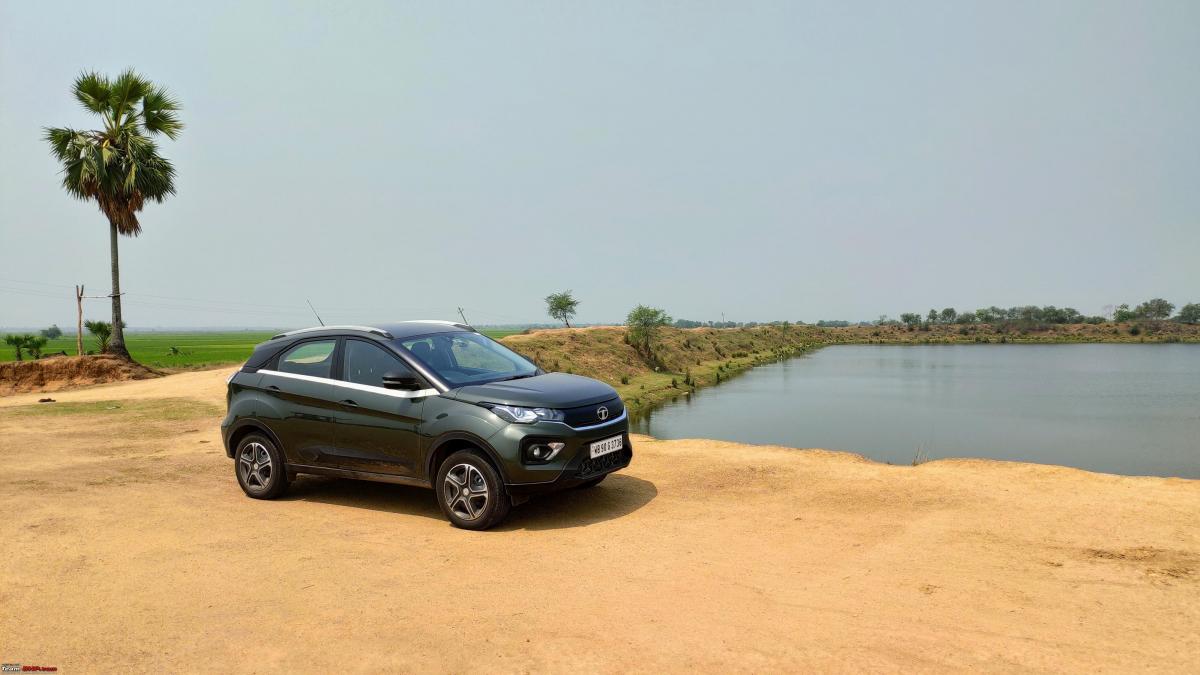
What you’ll like:
- Very well-priced for what it offers. Undercuts all rivals
- Funky styling ensures that the Nexon stands out from the crowd
- 5-star NCAP safety rating & a solid build, unlike many of its flimsy competitors
- Nice, spacious cabin with comfortable seats. You get a practical 350-litre boot too
- 1.5L diesel & 1.2L petrol offer good performance. Diesel is especially impressive
- Balanced road manners for such a tall car. Fine EPS & 209 mm of ground clearance!
- Loaded with features: Driving modes, LED DRLs, reversing camera, 8-speaker ICE etc.
- Dual airbags, ABS & Isofix child seat mounts are standard on all variants
What you won’t:
- Overdone design will be a turnoff for many of you. Rear-end is way too busy
- Jiggly low-speed ride; bumps are felt in the city (unlike other Tata cars)
- 3-cylinder petrol can't match 4-cylinder competition in NVH. Has lag too
- The observant eye will notice some rough edges in fit, finish & quality
- Concerns over long-term reliability, more so of the freshly developed engines
- Missing essentials (telescopic steering adjustment, auto-dimming IRVM, proper dead pedal)
- Tata's inconsistent after-sales experience is far from that of Maruti & Hyundai
- Shorter service/checkup interval of 6 months & 7,500 km (rivals have 12-month gaps)
Maruti Ignis
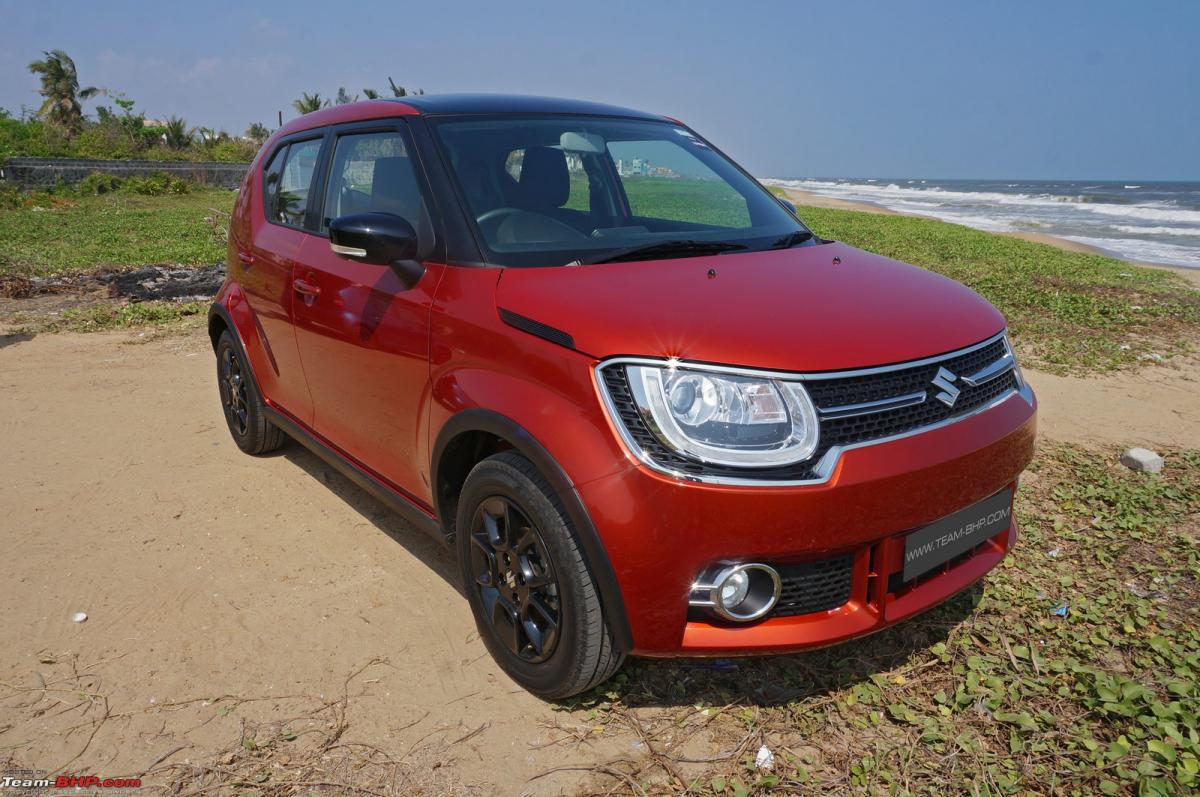
What you'll like:
- Unique, funky design - exterior & interior stand out in a crowd. Customisation options available
- Smart packaging! Good legroom & headroom in such a small car. Useable 260-litre boot too
- Peppy petrol engine and AMT
- Dual airbags, ABS with EBD and ISOFIX child seat anchors are standard across all variants
- Maruti's widespread service network, excellent after-sales support & fuss-free ownership experiences
- Features such as LED projector headlamps + DRLs, reversing camera, Apple & Android ICE, navigation, electrically-foldable ORVMs etc.
What you won't:
- Simply overpriced, not a VFM Maruti. Top trim is especially pricey
- You can buy more accomplished cars for a little more (Baleno) money
- Weird rear-end styling. Overall, the unconventional looks will polarize opinions
- No turbo petrol or diesel option. Period. Rivals offer both
- AMT, although improved, still can’t match conventional ATs on smoothness or speed
- Narrow cabin width. Rear seat is better for 2 adults than 3
- 32-liter fuel tank is too small for this segment. Even the humble Alto gets a larger tank
Here's what GTO had to say on the matter:
The Sonet is my top choice among all the Compact SUVs. It's got looks, style, equipment, good engines & a sorted suspension. Second choice, Nexon.
The Punch is lovely in every area, except for the one that matters the most = under the hood!!! That 1.2L NA motor is weak, the AMT is horrendous & the pricing of higher variants too much. When Tata gives it a turbo-petrol, I will consider it. Problem is, they haven't left pricing room for the turbo-petrol.
Here's what BHPian Shreyans_Jain had to say on the matter:
There is no car in this segment that is complete in all respects. They all have a catch, a compromise attached, a deal-breaker if you will. Nexon is excellent on most counts but is let down by the stupid AMT and the now optimistic pricing. Ditto for the XUV300, which has the additional handicap of a tiny boot. Sonet and Venue are cramped for space and have questionable safety. Brezza is old, feels outdated and makes do with the obsolete 4 speed AT. There is no redeeming CNG option either. I don’t think Ignis and Punch belong to this category of vehicles, they are a full segment down in all respects.
Surprisingly, it is the Kiger and Magnite that seem to provide the best overall combination of powertrains, space, features, safety and value. Granted, the cabin isn’t as well-appointed as the Venue. But the overall proposition is very good and the price tag is killer. Especially for the turbo petrol CVT.
Too bad the Ecosport has been discontinued, it would have still been my top pick otherwise.
Here's what BHPian harry10 had to say on the matter:
Voted for Sonet.
I own the D-AT one. Engine and gearbox are a gem. All required features are present and then some. Space is good enough for a 6.1 driver like me. Ergonomics are sorted, interiors are pleasing and feel roomy, handling is almost like a sedan with negligible body roll, A.S.S has been a good experience so far, looks are subjective but I like it. Mileage is between 14-16kmpl in NCR with AC and highways it can easily give 20kmpl. Also, NVH is brilliant, coming from a diesel Honda City this is super silent.
Stiff suspension is the only negative for our potholed roads, however with the right tyre pressure and once you learn to adjust your driving style it's easily negotiable. No GNCAP rating so I will give it a benefit of the doubt until it's done but I find the build quality better than my previous Honda City. Also, the thud from the doors and heavy bonnet is a little reassuring.
All in all, at 4300km ODO currently I am a very satisfied owner so far. Touchwood
My only other contender was Nexon and it would have won but for one deal-breaker - AMT gearbox. Would have surely bought it if there was a TC unit. Tata needs to sort this out as I know a lot of people who didn't buy Nexon just because of the gearbox.
Here's what BHPian amvj had to say on the matter:
I voted for the Nexon.
Pros:
- 5 star NCAP rating.
- Huge ground clearance.
- Good Diesel engine.
- Good Handling and steering.
- The interiors look decent.
- Very little niggles compared to other Tata products.
- The front three quarters look decent compared to over-styled Sonet or ugly Venue or the dull and boring Vitara Brezza.
Cons:
- Digital speedo is an eyesore. Looks like a cheap Casio watch.
- The rear design and a white stripe along the body is ugly.
Check out BHPian comments for more insights and information.
- Tags:
- Indian
- Compact SUV
- Comparo
News
MG to launch Brezza, Venue, Nexon rivaling sub-4m SUV
The new platform will serve as the base for not only a sub-4 meter SUV but also a hatchback and an MPV.
MG Motor India is gearing up to launch the Astor - a new crossover that will be positioned below the Hector. However, that's not the only small SUV that MG has in the pipeline for India.
According to a recent report, the carmaker is developing a new platform that will spawn a sub-4 meter SUV. It will compete with the likes of the Maruti Suzuki Vitara Brezza, Hyundai Venue and Tata Nexon.
The report states that MG had initially thought of re-engineering the Baojun 510 into a sub-4 meter model. But instead, the carmaker has now decided to develop a completely new platform that would serve as the base for not only a sub-4 meter SUV but also a hatchback and an MPV.
Right now, the carmaker's main focus is on expanding the production capacity at their Halol plant to 1,00,000 units per annum. This is being done to accommodate the Astor. It is said that MG will enter the sub-4 segment only after its second plant comes online.
MG's sub-4 meter crossover is expected to debut post-2023, followed by the MPV and hatchback.
Source: Autocar India
News
Fiat Pulse compact SUV interiors unveiled
The Fiat Pulse is said to be underpinned by FCA's new MLA platform.
Fiat unveiled its all-new Pulse compact-SUV earlier this year. Now, the company has released the first set of images revealing the interiors of the SUV.
The new Fiat Pulse features a clean and minimalistic cabin layout while being equipped with a host of features and equipment. The cabin of the compact SUV comes with a 7.0-inch fully digital instrument cluster, a 10.1-inch floating touchscreen infotainment system with smartphone connectivity, a 'Sport' button on the steering wheel, automatic climate control, and plenty more.
The Fiat Pulse is said to be underpinned by FCA's new MLA platform, capable of incorporating newer technologies such as 4x4 and hybrid systems in the future. The Pulse is said to be around 4 metres in length, positioning it below the Jeep Renegade in FCA's global lineup.
The compact SUV from Fiat will come powered by two engine options. These include a 1.3-litre, 4-cylinder, petrol engine producing 109 BHP and 140 Nm, paired with a 5-speed manual, as well as a 1.0-litre 3-cylinder turbo-petrol unit, churning out 120 BHP and 196 Nm, mated to a CVT transmission.
- Tags:
- Indian
- Compact SUV
- International
News
Skoda’s India-specific sub-4 m SUV could arrive by 2023
The vehicle is being referred to as project 2.5. Skoda plans to keep its price competitive by localising over 95% of its parts.
Skoda Auto Volkswagen is planning to introduce a new sub-4-metre SUV in India. This segment contains some of the highest-selling cars in the country such as the Maruti Vitara Brezza, Hyundai Venue, Kia Sonet and Tata Nexon. The segment accounts for 15% of the overall passenger vehicle market. With 50,000 units sold a month, more than half of the utility vehicles sold in India are from this segment.
The new SUV is expected to be designed in Europe. But, Skoda plans to keep its price competitive by localising over 95% of its parts.
According to a media report, the Skoda-badged model will be India-specific and will go on sale in the second half of 2023. The vehicle is being referred to as project 2.5. At present, the company has a market share of less than 1.5%. With the new model, by 2025, Skoda is looking to increase this share to 5%. It plans to sell 50,000 units of the SUV per year.
Under its 2.0 strategy, the Volkswagen Group plans to invest more than 1 billion euros in India. The group plans to introduce a sub-compact SUV since sub-4 metre vehicles benefit from a significantly lower tax rate, compared to those greater than 4-metres in length.
Source: ET Auto
- Tags:
- Indian
- Volkswagen
- Compact SUV
News
Brazil: New Fiat compact-SUV to be called Pulse
Fiat has confirmed the name 'Pulse' for its new compact-SUV after it won the public poll.
Fiat has announced that its new compact-SUV will be called 'Pulse'. The new Fiat Pulse was unveiled earlier this year, codenamed 'Progetto 363' and is expected to go on sale in the Brazilian market later this year.
The Italian carmaker held an online public poll, allowing prospective customers to choose the name for the new SUV. Of the three names shortlisted, the 'Pulse' name won the poll with 65% of the votes. The other two names were Domo and Tuo, both of which managed just 25% and 10% of the votes, respectively.
The new Fiat Pulse is expected to be underpinned by the brand's new modular platform, called MLA. The new platform is said to be stiffer and stronger than the previous PM1 architecture. The new platform is also said to be capable of incorporating newer technologies such as hybrid and 4x4 powertrains in the future.
The company also announced that the Pulse will have a length of around 4 metres, positioning it below the Jeep Renegade SUV, in FCA's global line-up.
The Fiat Pulse will come powered by two engine options. These include a 1.3-litre four-cylinder engine producing 109 BHP and 140 Nm, paired with a 5-speed manual gearbox. The second engine is a 1.0-litre three-cylinder turbo-petrol unit churning out 120 BHP and 196 Nm, mated to a CVT transmission.
- Tags:
- Indian
- Compact SUV
- International
Pages



